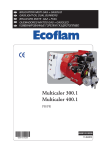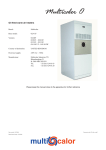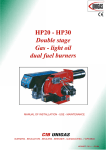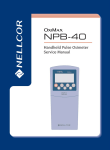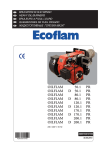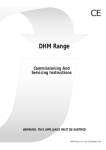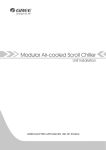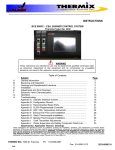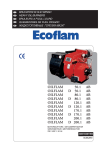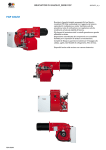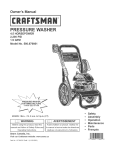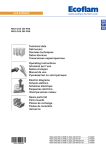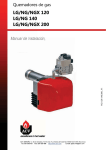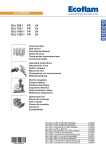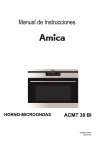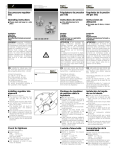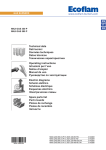Download Multicalor 170.1 P AB Multicalor 200.1 P AB
Transcript
IT EN BRUCIATORI MISTI GAS + GASOLIO GAS/LIGHT-OIL DUAL BURNERS Multicalor 170.1 P AB Multicalor 200.1 P AB 230/400 V 50 Hz 420010399601 22.10.2013 IT 420010399601 MULTICALOR 170.1 -200.1 P AB Indice 1 - Dati tecnici - Caratteristiche tecniche . . . . . . . . . . . . . . . . . . . . . . . . . . . . . . . . . . . . . . . . .p.3 - Campo di lavoro . . . . . . . . . . . . . . . . . . . . . . . . . . . . . . . . . . . . . . . . . . . . . .p.3 - Dimensioni di ingombro . . . . . . . . . . . . . . . . . . . . . . . . . . . . . . . . . . . . . . . . .p.3 2 - Installazione - Allacciamento elettrico . . . . . . . . . . . . . . . . . . . . . . . . . . . . . . . . . . . . . . . . .p.4 - Allacciamento gas . . . . . . . . . . . . . . . . . . . . . . . . . . . . . . . . . . . . . . . . . . . . .p.4 - Schema di collegamento bruciatori a gas con valvola pilota . . . . . . . . . . . . .p.4,5 3 - Avviamento e regolazioni gas - Funzionamento del bruciatore . . . . . . . . . . . . . . . . . . . . . . . . . . . . . . . . . . . .p.5 Regolazione della combustione . . . . . . . . . . . . . . . . . . . . . . . . . . . . . . . . . .p.5 Funzionamento apparecchiatura di controllo . . . . . . . . . . . . . . . . . . . . . . . .p.6 Circuito gas . . . . . . . . . . . . . . . . . . . . . . . . . . . . . . . . . . . . . . . . . . . . . . . . . .p.7 Regolazioni pressostati . . . . . . . . . . . . . . . . . . . . . . . . . . . . . . . . . . . . . . . . .p.7 Regolazioni aria / gas . . . . . . . . . . . . . . . . . . . . . . . . . . . . . . . . . . . . . . . . . .p.8 Regolazioni testa . . . . . . . . . . . . . . . . . . . . . . . . . . . . . . . . . . . . . . . . . . . . . .p.9 Controllo sistema di rivelazione fiamma . . . . . . . . . . . . . . . . . . . . . . . . . . . .p.9 Smontaggio testa . . . . . . . . . . . . . . . . . . . . . . . . . . . . . . . . . . . . . . . . . . . . .p.9 4 - Avviamento e regolazioni gasolio - Circuito gasolio . . . . . . . . . . . . . . . . . . . . . . . . . . . . . . . . . . . . . . . . . . . . . . .p.10 Alimentazione olio combustibile . . . . . . . . . . . . . . . . . . . . . . . . . . . . . . . . . .p.10 Innesco e regolazione della pompa . . . . . . . . . . . . . . . . . . . . . . . . . . . . . . .p.11,12,13 Tabella ugelli . . . . . . . . . . . . . . . . . . . . . . . . . . . . . . . . . . . . . . . . . . . . . . . . .p.13 Funzionamento del bruciatore . . . . . . . . . . . . . . . . . . . . . . . . . . . . . . . . . . . .p.14 Posizione e pulizia elettrodi . . . . . . . . . . . . . . . . . . . . . . . . . . . . . . . . . . . . . .p.14 Pannello comando . . . . . . . . . . . . . . . . . . . . . . . . . . . . . . . . . . . . . . . . . . . .p.15 5 - Uso e manutenzione - Anomalie di funzionamento . . . . . . . . . . . . . . . . . . . . . . . . . . . . . . . . . . . . . .p.15 pag.2 420010399601 MULTICALOR 170.1 -200.1 P AB CARATTERISTICHE TECNICHE 170.1 Modello : Multicalor 200.1 Potenza termica max. kW 1770 kcal/h 1.526.000 Potenza termica min. kW 342 kcal/h 295.000 Max. portata gas metano Nm3/h 178 Min. portata gas metano Nm3/h 34 Pressione gas metano mbar 20-700 Max. portata gasolio kg/h 150 Min. portata gasolio kg/h 29 Tensione di alim. trifase + neutro 50 Hz V 230/400 Potenza motore kW 3 Giri/minuto del motore N° 2800 Combustibile :P.c.i. metano = 35,9 Mj/Nm3 = 8.570 kcal/Nm3 P.c.i. gasolio = 10.200 kcal/Kg max 1,5° E a 20° C 2150 1.853.450 414 356.900 216 42 23-700 182 35 230/400 4 2800 CAMPO DI LAVORO mbar Contropressione in camera di combustione 12 10 M U 8 LT I C 6 A LO MULTICALOR 170.1 R 20 0. 4 1 2 0 200 20 30 600 600 400 200 10 400 40 800 800 1000 70 60 50 1000 80 1200 1200 90 1400 110 100 120 1400 1600 1600 130 1800 140 150 kcal/h 2000 x 1000 1800 2000 160 170 2200 180 190 kW kg/h Potenza DIMENSIONI D’INGOMBRO A E B C I M F L D - D1 H1 N MODELLI Multicalor 170.1 AB Multicalor 200.1 AB A 965 990 B 395 420 C 570 570 G O SUNTEC D 290 290 D = Testa corta D1 490 490 E 700 700 F 250 270 G 420 420 D1 = Testa lunga pag.3 H1 680 680 I 240 240 L 240 240 M M14 M14 N O 125 250 125 250 IT 420010399601 MULTICALOR 170.1 -200.1 P AB IT ALLACCIAMENTO ELETTRICO Tutti i bruciatori sono collaudati a 400 V 50 Hz trifase per i motori e 230V 50 Hz monofase con neutro per gli ausiliari. Se fosse necessario alimentare il bruciatore a 230 V 50 Hz trifase senza neutro, eseguire le modifiche necessarie riferendosi allo specifico schema elettrico del bruciatore e controllare che il relé termico sia entro il campo di assorbimento del motore. Accertare inoltre il corretto senso di rotazione del motore del ventilatore. ALLACCIAMENTO ALLA LINEA GAS Allacciato il bruciatore alla tubazione del gas è necessario assicurarsi che quest’ultima sia a tenuta perfetta. Assicurarsi pure che il camino non sia ostruito. Aperto il rubinetto del gas sfiatare con prudenza la tubazione attraverso l’apposita presa di pressione e quindi controllare il valore della pressione con un manometro idoneo. Dare tensione all’impianto e regolare i termostati alla temperatura desiderata. Alla chiusura dei termostati, il dispositivo di controllo fughe gas effettua una prova di tenuta delle valvole; Al termine della prova il bruciatore riceve il consenso per effettuare il ciclo di avviamento. SCHEMA DI COLLEGAMENTO PER BRUCIATORI A GAS CON VALVOLA PILOTA SEPARATA CONNECTION DIAGRAM FORgas BURNERS WITH SEPARATE PILOT (rampa Dungs MB-DLE...) (GAS TRAIN DUNGS MB-DLE...) 100 100 107 107 120 120 141 141 142 142 143 143 144 144 150 150 151 151 155 160 155 170 160 313 170 314 349 107 To be supplied by the installer 155 160 313 314 349 170 314 313 141 Bruciatore Burner Filtro/stabilizzatore per valvola Pilot gas filter/governor Air damperSerranda aria Ball valve Rubinetto di intercettazione Gas filter Filtro gas Antivibration coupling Giunto antivibrante Gas governor Stabilizzatore Batterfly valve Valvola gas Gas train Dungs MB-DLE.... Rampa gas Dungs MB-DLE.... Pilot gas train Kit tightnessRampa controlgas (optional) pilota Kit tightnessKit control for pilot valve (optional) controllo di gas tenuta ( opzionale) Min.gas pressure switch Kit collegamento controllo di tenuta Max.gas pressure switch (optional) gas pilota (opzionale) Air/gas damper motor per valvola Pressostato gas minima Pressostato gas massima (opzionale) Servocomando 100 143 150 Gas 151 To be supplied by the installer 120 Air M 349 SCHEMA DI COLLEGAMENTO PER BRUCIATORI A GAS CON VALVOLA PILOTA SEPARATA CONNECTION DIAGRAM FOR BURNERS WITH SEPARATE PILOT (rampa gas Kromschroder VCS...) (GAS TRAIN KROMSCHRODER VCS...) To be supplied by the installer 100 100 107 107 120 120 141 141 142 142 143 143 144 144 150 150 151 151 155 160 155 170 160 313 170 314 349 107 155 160 313 314 349 170 314 313 143 Pressostato gas minima Pressostato gas massima (opzionale) Servocomando 100 144 141 Bruciatore Burner Filtro/stabilizzatore per valvola Pilot gas filter/governor Air damper Serranda aria Ball valve Rubinetto di intercettazione Gas filter Filtro gas AntivibrationGiunto coupling antivibrante Gas governor Stabilizzatore Batterfly valve Valvola gasVCS.... Gas train Kromschroder Rampa gas Kromschroder VCS.... Pilot gas train Kit tightnessRampa control gas (optional) pilota Kit tightnessKit control for pilot valve (optional) controllo digas tenuta ( opzionale) Min.gas pressure switch Kit collegamento controllo di tenuta Max.gas pressure switch (optional) gas pilota Air/gas damper motor (opzionale) 142 150 Gas 151 To be supplied by the installer 120 Air M 349 pag.4 per valvola 420010399601 MULTICALOR 170.1 -200.1 P AB SCHEMA DI COLLEGAMENTO PER BRUCIATORI A GAS CON VALVOLA PILOTA SEPARATA CONNECTION DIAGRAM FOR BURNERS WITH SEPARATE PILOT (GAS(rampa TRAIN LANDIS gas VGD...) Landis VGD...) 100 100 107 107 120 120 141 141 142 142 143 143 144 144 150 150 151 151 155 155 160 160 170 170 313 313 314 314 349 349 107 To be supplied by the installer 155 160 170 314 313 Burner Bruciatore Pilot gasFiltro/stabilizzatore filter/governor per valvola Serranda aria Air damper Rubinetto di intercettazione Ball valve Filtro gas Gas filter Giuntocoupling antivibrante Antivibration Stabilizzatore Gas governor BatterflyValvola valve gas Rampa gas VGD.... Landis VGD.... Gas train Landis Rampa gas pilota Pilot gas train Kit controllo di tenuta ( opzionale) Kit tightness control (optional) Kit collegamento controllo di tenuta per valvola Kit tightness control for pilot gas valve (optional) gas pilota (opzionale) Min.gasPressostato pressuregas switch minima Max.gasPressostato pressuregas switch (optional) massima (opzionale) Air/gas Servocomando damper motor 100 144 141 143 142 150 Gas 151 To be supplied by the installer 120 Air M 349 AVVIAMENTO DEL BRUCIATORE Dopo aver terminato la regolazione del bruciatore ”funzionamento a gasolio”, si può procedere alla taratura del bruciatore “funzionamento a gas”. Controllare l’esecuzione dell’allacciamento alla tubazione del gas e tutte le sicurezze previste dalle normative. Verificare sulla targhetta del bruciatore che tipo di combustibile, e la pressione di alimentazione siano corrette e corrispondenti all’utilizzo nell’installazione. Spurgare l’aria della tubazione del gas attraverso la presa di pressione e controllare il valore della pressione stessa. Posizionare il selettore del combustibile su “funzionamento a gas” e avviare il bruciatore. L’apparecchiatura di controllo fiamma dà il consenso alla verifica della tenuta delle valvole, al ter2 mine della verifica da inizio al ciclo d’avviamento. Il motoriduttore porta la serranda dell’aria 1 alla massima apertura: raggiunta questa posizione inizia il ciclo di preventilazione della durata 0 − STOP 1 − GASOLIO di circa 30 secondi. Alla fine della preventilazione, il motoriduttore porta la serranda aria in 2 − GAS 0 bassa fiamma permettendo l’accensione del bruciatore alla minima portata. Contemporaneamente il trasformatore d’accensione viene alimentato e dopo 3 secondi vengono alimentate le valvole del gas. Due secondi dopo l’apertura delle valvole, il trasformatore é escluso dal circuito. In caso di mancata accensione il bruciatore va in blocco entro 3 secondi. Il bruciatore si trova in funzionamento in 1° fiamma : Regolare la portata del gas in modo da ottenere una buona combustione con l’aria della serranda già tarata per il gasolio. Portare il bruciatore in 2° fiamma e regolare la portata del gas in modo da ottenere una buona combustione. Le camme di apertura e chiusura del motoriduttore nella regolazione “funzionamento a gas” non devono essere modificate in quanto sono già regolate nel “funzionamento a gasolio”. REGOLAZIONE DELLA COMBUSTIONE (METANO) ATTENZIONE : per ottenere una corretta regolazione della combustione e della portata termica occorre effettuare l'analisi dei fumi, servendosi degli appositi strumenti. La regolazione della combustione e della portata termica va eseguita contemporaneamente ad una analisi dei prodotti della combustione, assicurandosi che i valori riscontrati siano corretti, e, in ogni caso, rispondenti alle normative di sicurezza vigenti. A tal proposito vedere la tabella e la figura sottostanti. TALE OPERAZIONE DEVE ESSERE ESEGUITA DA PERSONALE PROFESSIONALMENTE QUALIFICATO ED AUTORIZZATO DALLA ECOFLAM SPA . VALORI DI RIFERIMENTO CONSIGLIATI CO2 GPL 11,7% CO <50 ppm 25 20 15 10 FATTORE D'ARIA CO <100 ppm 1,3 30 ECCESSO D'ARIA (%) CO2 Metano 9,6% 1,25 1,2 1,2 1,2 1,15 1,1 10 20 30 40 50 60 70 80 100 90 pag.5 200 300 400 500 600 800 1000 700 900 2000 3000 IT IT 420010399601 MULTICALOR 170.1 -200.1 P AB APPARECCHIATURA LME22 Diagramma connessioni collegamenti interni LME22... Connection diagram and control e sequence LME22… / LME23… B A B´ C D SB / R W / GP EK μC control NT RESET 12 AL 10 I K1 K2/1 12 2 LK FSV K2/2 10 3 K4 K3 7 4 R/W 5 11 6 9 8 1 LP AL M Z BV1 BV2 SA EK 7 9 BV1 4 (LR) BV2 5 pa GP 3 Z SA ION T M Nur LME23... 12 2 1 sw br bl QRC LP 6 FS 1 EK2 8 t10 t1 t12 tw STB H L Si N 11 t3 t3n TSA t4 7101d02/0606 t11 7101a02e/0606 AGK25... resistenza PTC AL Segnalazione di blocco esterma V... Valvola combustibile CPI Indicatore di posizione chiusa DBR... Collegamento EK Pulsante di sblocco (interno) EK2 Pulsante di sblocco remoto ION Elettrodo di rivelazione FS Segnale di fiamma FSV Amplificatore del segnale di fiamma GP Pressostato gas H Interuttore principale HS Contatto ausiliario rele’ K1...4 Contatti dei rele’ di controllo interni KL LK LKP LP LR M R SA STB Si W Z ZV A B-B´ C Bassa fiamma Serranda aria Posizione serranda aria Pressostato aria Termostato alta/bassa Motore del bruciatore Termostato di lavoro Servocomando Termostato di sicurezza Fusibile esterno Termostato o pressostato limite Trasformatore di accensione Valvola gas pilota Comando inizio ciclo Intervallo accensione fiamma Posizione funzionamento C-D D t1 t3 t3n t4 t10 t11 t12 TSA tw bruciatore Funzionamento bruciatore Spegnimento comandato da R tempo di preventilazione tempo di preaccensione tempo di postaccensione intervallo prima del consenso al 2° stadio Tempo disponibile per il segnale pressostato aria Tempo d'apertura programmato dal servocomando «SA» Tempo di chiusura programmato dal servocomando «SA» Tempo di sicurezza all’accensione Tempo di attesa Tabella codici LED multicolore Stato Stato di attesa Fase di accensione Funzionamento, fiamma ok . Funzionamento, fiamma non ok Segnale di fiamma estraneo Bassa tensione Blocco Codice di errore Trasmissione codice di errore Legenda : ....... Accesa continua Codice colore ❍ ................................................................................... ●❍●❍●❍●❍●❍●❍●❍●❍●❍●❍●❍ ❑................................................................................... ❑❍❑❍❑❍❑❍❑❍❑❍❑❍❑❍❑❍❑❍❑❍ ❑▲❑▲❑▲❑▲❑▲❑▲❑▲❑▲❑▲❑▲❑▲ ●▲●▲●▲●▲●▲●▲●▲●▲●▲●▲●▲ ▲................................................................................... ▲❍ ▲❍ ▲❍ ▲❍ ▲❍ ▲❍ ▲❍ ▲❍ ▲ ▲ ▲ ▲ ▲ ▲ ▲ ▲ ▲ ▲ ▲ ▲ ▲ rosso ❑ verde ❍ Spenta ● giallo pag.6 Colore spento giallo lampeggiante verde verde lampeggiante verde-rosso giallo-rosso rosso rosso lampeggiante rosso lampeggiante veloce 420010399601 MULTICALOR 170.1 -200.1 P AB Tabella codici errori Lampeggi (LED) «AL» term. n°10 Possible cause 2 lampeggi on Assenza di fiamma al termine del tempo di sicurezza all’accensione «TSA» - elettrovalvole difettose - rilevatore fiamma difettoso - regolazione bruciatore errata - elettrodi difettosi 3 lampeggi on 4 lampeggi 5 lampeggi on on 6 lampeggi 7 lampeggi on on 8 lampeggi 9 lampeggi 10 lampeggi on on off Guasto pressostato aria - Mancanza del segnale pressostato aria dopo«t10», - Contatti pressostato aria incollati in posizione di riposo Segnale fiamma estraneo Segnale pressostato aria fuori tempo Contatti pressostato aria incollati in posizione di lavoro Non utilizzati Troppe mancanze di fiamma durante il funzionamento (superato il limite del n° di ripetizioni del ciclo) - elettrovalvole difettose. - rilevatore fiamma difettoso - regolazione bruciatore errata. Non utilizzati Non utilizzati Contatti in uscita difettosi o guasto del dispositivo interno od errore nel cablaggio 14 lampeggi on Indicatore di posizione chiusa aperto CALCOLO DELLA PORTATA DI FUNZIONAMENTO DEL BRUCIATORE e = Litri di gas s = Tempo in secondi Per calcolare la portata di funzionamento, in kW, del bruciatore, procedere nel modo seguente: Controllare al contatore la quantità di litri erogati e la durata, in secondi, della lettura, quindi procedere al calcolo della portata secondo la seguente formula: e x f = kW s f G20 = 34,02 G25 = 29,25 G30 = 116 G31 = 88 CIRCUITO IDRAULICO GAS 1 2 3 4 5 6 7 8 9 - POMPA VALVOLA GASOLIO DI SICUREZZA VALVOLA GASOLIO 1° STADIO VALVOLA GASOLIO 2° STADIO UGELLO 1° STADIO UGELLO 2° STADIO PRESSOSTATO GAS DI MINIMA VALVOLA GAS DI SICUREZZA VALVOLA GAS Vg1 VgS 1 2 ASPIRAZIONE Vg1 VgS 5 3 1 2 5 3 ASPIRAZIONE RITORNO Vg2 RITORNO Vg2 4 4 1° STADIO GAS 2 STADIO GAS VGS 7 VG 9 8 VGS 6 7 8 VG 6 9 TARATURA DEL PRESSOSTATO GAS DI MINIMA PRESSIONE 45 40 30 35 50 25 N 5 20 2,5 - svitare le viti I e L e togliere il coperchio M - posizionare il regolatore N ad un valore pari al 60% della pressione nominale di alimentazione gas (es.: per gas metano press. nominale =20 mbar; regolatore posizionato al valore 12 mbar. - rimontare il coperchio M e riavvitare le viti I e L M 10 15 TARATURA DEL PRESSOSTATO ARIA - svitare le viti A e B e togliere il coperchio C - tarare il pressostato aria al minimo, ruo- I tando il regolatore D in posizione 1. - avviare il bruciatore e impostare il funzionamento L in 1° stadio (1 fiamma). - verificare la corretta combustione. con l’ausilio di un cartoncino ostruire progressivamente il condotto di aspirazione dell’aria fino ad ottenere un aumento del valore di CO2 di circa 0,5÷0,8 %, oppure, se si dispone di un manometro collegato alla presa di pressione E, fino ad ottenere una diminuzione di 0,1 mbar (~10 mm C.A.). D - aumentare lentamente il valore di taratura del pressostato, fino a causare lo spegnimento in C blocco del bruciatore. - togliere l’ostruzione al condotto di aspirazione aria e rimontare il coperchio C. - ripristinare il funzionamento del bruciatore agendo sul pulsante di sbloc- A G co dell’apparecchiatura. B N.B.) - La pressione misurata alla presa E deve rientrare nel campo di lavoro del pressostato. Se ciònon fosse. allentare il dado di bloccaggio alla base della vite F ed agire gradualmente sulla stessa; in senso orario per diminuire la pressione, antiorario per aumentarla. Al termine della regolazione, ribloccare il dado di bloccaggio. 2,7 2,4 1,5 1,8 2,1 3,0 1,2 0,4 0,6 pag.7 0,9 H E F IT IT 420010399601 MULTICALOR 170.1 -200.1 P AB SERVOCOMANDO ARIA SIEMENS SQN 30 151A2700 Togliere il coperchio per accedere alle camme di regolazione. Lo spostamento delle camme va effettuato con l’ausilio dell’apposita chiavetta in dotazione. Descrizione : I - Camma di regolazione posizione di apertura in 2° fiamma (potenza max.) II - Camma di regolazione della posizione serranda allo spegnimento (chiusura) III- Camma di regolazione posizione di apertura in 1° fiamma (potenza min.) V - Camma di consenso all’apertura dell’elettrovalvola del 2° stadio NOTA: La camma V (di consenso all’apertura dell’elettrovalvola del 2° stadio) va regolata in una posizione intermedia tra quella di 1° fiamma e quella di 2° fiamma (ad un angolo di circa 5° superiore a quello della posizione di 1° fiamma). LEVA DI BLOCCO BRUCIATORI VERSIONE “PAB” ASSEMBLAGGIO E REGOLAZIONE DELLA RAMPA GAS Montare la rampa gas fissando le viti della flangia e facendo attenzione al corretto posizionamento della guarnizione di tenuta. Collegare elettricamente la rampa gas tramite la spina a 6 poli. Accendere il bruciatore (in fabbrica è già stata eseguita una pre-taratura di massima) e verificare la tenuta dei raccordi gas eseguiti in sede di installazione. Per adeguare il bruciatore all’effettiva potenza della caldaia agire come segue: Alta fiamma 1. Portare il bruciatore in alta fiamma (la posizione della serranda aria deve essere impostata a 75° (apertura massima), per regolare la portata dell'aria agire sulla posizione della testa di combustione. Solo in particolari casi è necessario ridurre l'aria in alta fiamma, chiudendo l’aspirazione. 2. La posizione della farfalla gas dovrà essere inferiore ai 90° (es.85°, è importante non superare i 90° per ottenere un'ottima combustione durante il passaggio da alta a bassa fiamma). Correggere eventualmente questa posizione agendo sull’albero B dopo aver allentato la vite A. 3. Regolare la portata del gas in alta fiamma tramite lo stabilizzatore, o agendo sulla valvola del gas regolabile. Attenzione :Le istruzioni per la taratura delle valvole gas sono comprese nel manuale delle rampe. A Bassa fiamma 4. Scegliere la posizione di primo stadio sul servocomando (normalmente compresa tra 10° e 30°) in base alla potenza di carico ridotto richiesta, e commutare in bassa fiamma. 5. Regolare la portata del gas per ottenere la combustione ottimale, per variare la posizione della valvola a farfalla agire sulla barra esagonale C dopo aver allentato i dadi D. B D C Operazioni successive 6. Portare il bruciatore in alta fiamma ,ed eventualmente riposizionare la valvola a farfalla come indicato al punto 2. 7. Se necessario, ripetere più volte le operazioni descritte ai punti 5 e 6 per ottenere le posizioni esatte della valvola a farfalla, sia in alta che in bassa fiamma. 8. Fissare i dadi. D pag.8 420010399601 MULTICALOR 170.1 -200.1 P AB REGOLAZIONE DELLA COMBUSTIONE ATTENZIONE: Ai fini di una corretta regolazione della combustione e della portata termica, queste vanno eseguite contemporaneamente ad una analisi dei fumi, da effettuarsi con strumenti appositi, controllamndo che i valori riscontrati siano corretti e rispondenti alle normative di sicurezza in vigore. Le operazioni di rgolazione debbono essere effettuate da personale qualificato ed autorizzato dalla Ecoflam S.p.A. REGOLAZIONE POSIZIONE TESTA DI COMBUSTIONE La regolazione della posizione della testa di combustione viene effettuata per ottenere il miglior rendimento di combustione. Nelle applicazioni alle portate minime del bruciatore la testa viene arretrata, alle potenze massime viene avanzata. Esecuzione: - allentare la vite A adoperando una chiave a brugola adeguata - agire con un cacciavite sulla vite esagonale B sino al raggiungimento della posizione desiderata - rifissare la vite A. SMONTAGGIO DEL BOCCAGLIO A + -– + B SMONTAGGIO TESTA DI COMBUSTIONE RIVELAZIONE FIAMMA SW AGQ3.1A27 Il controllo della corrente di rivelazione si effettua inserendo un microamperometro con fondo scala di 1000 µA (corrente continua) in serie alla fotocellula. Se la corrente di rivelazione è troppo bassa verificare il collegamento fase e neutro del bruciatore e la messa a terra del bruciatore stesso. Normalmente il valore della corrente di rivelazione è 200 µA. 1 BL pag.9 LME22 BL QRA SW SW = NERO BL = BLU 2 IT IT 420010399601 MULTICALOR 170.1 -200.1 P AB CIRCUITO IDRAULICO GASOLIO A B C 1 2 3 4 5 6 7 8 9 - FLESSIBILI FILTRO RUBINETTO POMPA VALVOLA GASOLIO DI SICUREZZA VALVOLA GASOLIO 1° STADIO VALVOLA GASOLIO 2° STADIO UGELLO 1° STADIO UGELLO 2° STADIO PRESSOSTATO GAS DI MINIMA VALVOLA GAS DI SICUREZZA VALVOLA GAS Vg1 VgS 1 2 5 3 ASPIRAZIONE RITORNO Vg2 4 1° STADIO GASOLIO VGS VG 9 8 7 Vg1 VgS 1 2 6 5 3 ASPIRAZIONE RITORNO Vg2 4 A 2° STADIO GASOLIO VGS A B 7 C 8 VG 9 6 ALIMENTAZIONE COMBUSTIBILE Bitubo dalla sommità del serbatoio H Bitubo in aspirazione H H Lunghezza tubazioni (m) (m) J7 ø 14 mm ø 16 mm 0 0,5 1 2 3 3,5 16 18 20 25 29 31 29 33 37 44 52 55 H Lunghezza tubazioni (m) (m) J7 ø 14 mm ø 16 mm 0 0,5 1 2 3 3,5 pag.10 16 14 12 7 3 1 29 26 22 14 7 4 Per la lunghezza delle tubazioni, bisogna considerare tutte le parti rettilinee, le curve, le salite e le discese. L'altezza statica di aspirazione è la distanza tra la valvola di fondo e l'asse della pompa del bruciatore. La depressione non deve superare 0,45 bar ; in caso di depressione maggiore la pompa si può deteriorare, con conseguente aumento dei rumori meccanici ed eventuale rottura. 420010399601 MULTICALOR 170.1 -200.1 P AB INNESCO E REGOLAZIONE DELLA POMPA GASOLIO SUNTEC J7 SUNTEC AJ 6 C-C 3 1 4 6 5 1 2 3 4 5 6 SUNTEC - ASPIRAZIONE RITORNO SFIATO E PRESA MANOMETRO PRESA VUOTOMETRO REGOLAZIONE PRESSIONE ALL' UGELLO SUNTEC 6 5 4 3 2 2 1 CONTROLLARE: - Che le tubazioni siano perfettamente a tenuta. - Che siano usati tubi rigidi (preferibilmente di rame), ove possibile. - Che la depressione in aspirazione non ecceda 0,45 bar, per evitare che la pompa entri in cavitazione. - Che la valvola di fondo sia dimensionata correttamente. La pressione della pompa viene regolata al valore di 12 bar durante il collaudo del bruciatore. Prima di avviare il bruciatore, spurgare l’aria contenuta nella pompa attraverso la presa del manometro. Riempire le tubazioni di gasolio per facilitare l’innesco della pompa. Avviare il bruciatore e verificare la pressione di alimentazione della pompa. Se l’innesco della pompa non dovesse avvenire durante il primo prelavaggio, con conseguente, successiva entrata in blocco del bruciatore, riarmarne il blocco per riavviarlo, premendo il pulsante rosso sull’apparecchiatura di controllo. Se, ad innesco della pompa avvenuto, il bruciatore dovesse andare in blocco dopo la fase di prelavaggio, a causa di una caduta di pressione del gasolio nella pompa, riarmarne il blocco per riavviarlo. Non permettere che la pompa funzioni per più di tre minuti senza gasolio. Nota: prima di avviare il bruciatore, assicurarsi che il tubo di ritorno sia aperto. Una sua eventuale occlusione provocherebbe una rottura dell’organo di tenuta della pompa. DATI TECNICI POMPA SUNTEC AJ NB : Per impianti monotubo, togliere il grano di by-pass inserito sull'attacco del vuotometro e chiudere l'attacco di ritorno mediante un tappo d'acciaio ed una rondella. IDENTIFICAZIONE DELLA POMPA (Non tutte le combinazioni sono disponibili. Contattare Suntec) AJ : regolazione della pressione Capacità dell'ingranaggio (vedi curve di portata pompa) Campo di pressione C : 10-20 bar E : 10-30 bar 6 C C 1 000 Grano di by-pass tolto Olio in pressione Ritorno dell'olio non utilizzato al serbatoio o all'aspirazione Senso di rotazione e posizione attacco mandata all'ugello (visti dal lato estremità albero) A : rotazione oraria / attacco mandata destra. B : rotazione oraria / attacco mandata sinistra. C : rotazione antioraria / attacco mandata sinistra. D : rotazione antioraria/ attacco mandata destra. AJ Ritorno all'aspirazione Olio in aspirazione Ritorno chiuso INSTALLAZIONE MONOTUBO Attacco manometro pressione Vite di regolazione della pressione All'ugello 4 P Ingranaggio Montaggio a flangia Grano di by-pass inserito 000 : modello standard con funzione di taglio 002 : raccordo all'ugello forato, senza taglio 003 : albero Ø 8 mm con funzione di taglio Tenuta albero Attacco vuotometro Numero di revisione Installazioni P : installazioni a 2 tubi, con grano di by-pass inserito sull'attacco vuotometro Ritorno Aspirazione pag.11 INSTALLAZIONE A 2 TUBI IT 420010399601 MULTICALOR 170.1 -200.1 P AB DATI TECNICI Portata della pompa Portata (L/h) 350 Generale Montaggio a flangia conformemente agli standard EN 225 Connessioni di collegamento cilindriche in accordo con ISO 228/1 Entrata e ritorno 300 G 1/4 Uscita all'ugello G 1/8 Attacco manometro pressione G 1/8 Attacco vuotometro 250 G 1/8 Funzione valvola regolazione della pressione e taglio* Filtre superficie utile : 30 cm2 AJ 6 200 (*salvo AJ 1002) 150 larghezza della maglia : 120 x 150 +m2 Albero AJ 4 AJ 1000/1002 : Ø 11mm (7/16") AJ 1003 : Ø 8 mm in accordo con standard EN 225 Grano di by-pass inserito sull'attacco vuotometro 100 5 10 30 35 Pressione (bar) Viscosità = 5 cSt - Velocità = 2850 gpm per installazione a 2 tubi ; da togliere con chiave tipo Allen 4 mm per installazione monotubo. Peso 15 20 Ref : SK272 - 24/11/1999 IT 25 Le caratteristiche indicate tengono conto di un margine di usura. Non aumentare le misure della pompa quando si sceglie la capacità dell'ingranaggio. 1,7 kg Dati idraulici Campo di pressione all'ugello C : 10 - 20 bar E : 10 - 30 bar Taratura di fabbrica 12 bar Campo viscosità 2 - 75 mm²/s (cSt) Temperatura olio 0 - 60°C nella pompa Pressione entrata 2 bar max. Pressione ritorno 2 bar max. Altezza di aspirazione 0,45 bar max. vuoto per evitera separazione aria dall'olio Velocità 3600 gpm max. Coppia (a 45 gpm) 0,30 N.m DATI TECNICI POMPA SUNTEC J NB : Per impianti monotubo, togliere il grano di by-pass inserito sull'attacco di ritorno e chiudere l'attacco di ritorno mediante un tappo d'acciaio ed una rondella. IDENTIFICAZIONE DELLA POMPA Ritorno all'aspirazione (Non tutte le combinazioni sono disponibili. Contattare Suntec) J : regolazione della pressione Capacità dell'ingranaggio (vedi curve di portata pompa) Olio in aspirazione Olio in pressione Ritorno dell'olio non utilizzato al serbatoio o all'aspirazione Grano di by-pass tolto Filtro Senso di rotazione e posizione attacco mandata all'ugello (vista lato albero) A:rotazione oraria / attacco mandata destra. B: rotazione oraria / attacco mandata sinistra. C: rotazione antioraria / attacco mandata sinistra. D: rotazione antioraria/ attacco mandata destra. Retorno chiuso INSTALLAZIONE MONOTUBO Attacco vuotometro Aspirazione Ingranaggio Campo di pressione C : 10-21 bar E : 10-30 bar J 6 C A C 1 001 Tenuta albero 5 P Montaggio a flangia Vite di regolazione della pressione 000 : attachi conici; funzione di taglio. 001 : attachi cilindrici; funzione di taglio. 002 : attachi cilindrici; raccordo all'ugello forato, senza taglio. All'ugello Attacco manometro pressione Grano di by-pass inserito Numero di revisione 5 : per J4 ed J6 4 : per J7 INSTALLAZIONE A 2 TUBI Installazioni P : installazioni a 2 tubi, con grano di by-pass inserito nel foro di ritorno. pag.12 Ritorno 420010399601 MULTICALOR 170.1 -200.1 P AB DATI TECNICI Portata della pompa Generalità Portata (L/h) 400 a flangia conforme agli standard EN 225. Modello1000 Modelli 1001/1002 Conici cilindrici in accordo con ISO 228/1 Entrata e ritorno 1/4"NPTF G 1/2 Uscita all'ugello 1/8"NPTF G 1/4 Attacco manometro pressione 1/8"NPSF Attacco vuotometro 1/4"NPTF G 1/8 G 1/2 Attacchi J7 300 J6 200 J4 Funzione della valvola regolazione della pressione e taglio (salvo J 1002). Filtro superficie utile : 45 cm² Albero Ø 11mm in accordo con standard EN 225. Grano di by-pass inserito nel foro di ritorno per installazione a 2 tubi ; Ref : SK264 - 20/03/2001 Montaggio 100 grado di filtraggio : 170 μm 0 5 10 15 20 30 4 kg Le caratteristiche indicate tengono conto di un margine di usura. Non aumentare le misure della pompa quando si sceglie la capacità dell'ingranaggio. Dati idraulici Campo di pressione all'ugello C : 10 - 21 bar E : 10 - 30 bar Taratura di fabbrica 12 bar Campo viscosità 2 - 75 mm²/s (cSt) Temperatura olio 0 - 90°C nella pompa. Pressione entrata 1,5 bar max. Pressione ritorno 1,5 bar max. Altezza di aspirazione 0,45 bar max. vuoto per evitare la separazione dell'aria dall'olio. Velocità 3600 gpm max. Coppia (a 45 gpm) 0,30 N.m PORTATA UGELLI DELAVAN B - MONARCH PLP UGELLO GPH 2,50 3,00 3,50 4,00 4,50 5,00 5,50 6,00 6,50 7,00 7,50 8,30 9,50 10,50 12,00 13,80 15,30 17,50 19,50 21,50 24,00 28,00 30,00 GPH 10 11 9,50 11,40 13,30 15,20 17,10 19,00 20,90 22,80 23,70 26,60 28,50 31,54 36,10 40,06 45,60 52,40 58,10 66,50 74,10 81,70 91,20 106,40 114,00 9,97 11,96 13,95 15,94 17,94 19,93 21,92 23,92 25,91 27,90 29,90 33,08 37,87 41,73 47,80 55,00 61,00 69,80 77,70 85,70 95,70 111,60 119,60 35 Viscosità = 5 cSt - Velocità = 2850 gpm installazione monotubo. Peso 25 Pressione (bar) da togliere con chiave tipo Allen 3/16" per PRESSIONE POMPA(bar) 12 13 14 10,41 12,49 14,57 16,65 18,73 20,82 22,90 24,98 27,06 29,14 31,22 34,55 39,55 43,74 50,00 57,50 63,70 72,90 81,20 89,50 99,90 116,60 124,90 10,83 13,00 15,17 17,33 19,50 21,67 23,83 26,00 28,17 30,33 32,50 35,97 41,17 45,41 52,00 59,80 66,30 75,80 84,50 93,20 104,00 121,30 130,00 PORTATA kg/h pag.13 11,24 13,49 15,74 17,99 20,24 22,48 24,73 26,98 29,23 31,48 33,73 37,32 42,72 47,20 54,00 62,10 68,80 78,70 87,70 96,70 107,90 125,90 134,90 15 16 11,64 13,96 16,29 18,62 20,95 23,27 25,60 27,93 30,26 32,58 34,91 38,63 44,22 48,90 55,90 64,20 71,10 81,50 90,80 100,10 111,70 130,30 139,60 12,02 14,42 16,83 19,23 21,63 24,04 26,44 28,84 31,25 33,65 36,05 39,90 45,67 50,50 57,70 66,30 73,60 84,10 93,70 103,40 115,40 134,60 144,20 IT IT 420010399601 MULTICALOR 170.1 -200.1 P AB AVVIAMENTO DEL BRUCIATORE A GASOLIO I bruciatori misti gas gasolio devono essere regolati sempre come prima accensione a gasolio. Dopo aver eseguito l’installazione del bruciatore, verificare i seguenti punti: - Tensione d’alimentazione del bruciatore ed i fusibili di protezione. - I collegamenti dei motori. - La corretta lunghezza delle tubazioni e la loro tenuta. - Il tipo di combustibile, che deve essere adatto al bruciatore. - Il collegamento dei termostati caldaia e le varie sicurezze. - Il senso di rotazione dei motori. - La corretta taratura delle protezioni dei motori. 2 1 Controllare che la portata degli ugelli sia proporzionata alla potenzialità della caldaia. 0 − STOP Montare un manometro gasolio sulla pompa stessa. Quando tutte queste condizioni sono veri- 12 −− GASOLIO GAS 0 ficate e soddisfatte, si può procedere alla prima accensione del bruciatore. Dare tensione al bruciatore. L’apparecchiatura di controllo alimenterà, il motore del ventilatore, che provvederà ad effettuare un prelavaggio della camera di combustione alla massima portata d’aria, e il motore pompa gasolio, che mette in pressione la pompa stessa. Al termine del prelavaggio il servocomando si predispone nella posizione di 1° stadio gasolio, l’apparecchiatura di controllo da tensione al trasformatore e apre le elettrovalvole “valvola di sicurezza” e “valvola 1° stadio”. Dopo l’intervallo di sicurezza di 3 secondi, ad accensione avvenuta, l’apparecchiatura di controllo disinserisce il trasformatore, dopo 10 secondi e alimenta il servocomando “serranda aria” porterà il bruciatore 2° stadio (ALTA). In caso di accensione difettosa, l’apparecchiatura di controllo causa il blocco del bruciatore entro 3 secondi. In questo caso riarmare il bruciatore. Per avere una combustione ottimale occorrerà regolare il 1° stadio (BASSA) e il 2° stadio (ALTA) seguendo le istruzioni fornite (regolazione servocomando aria e regolazione testa. Durante tale fase si potrà passare da uno stadio all’altro manualmente selezionando con il selettore (ALTA) 2°stadio, (BASSA) 1°stadio, alla fine delle operazioni selezionare la posizione (ALTA). Per una corretta taratura del bruciatore effettuare le prove di combustione al camino. POSIZIONE ELETTRODI 3 ÷ 4 mm 5 ÷ 6 mm PULIZIA E SOSTITUZIONE DELL’UGELLO Utilizzare solo la apposita chiave fornita in dotazione pre rimuovere l’ugello, facendo attenzione a non danneggiare gli elettrodi. Montare il nuovo ugello con la medesima cura. N.B.: Verificare sempre la posizione degli elettrodi dopo il montaggio dell’ugello (vedi figura). Una posizione errata può comportare problemi di accensione. DESCRIZIONE DEL PANNELLO DI CONTROLLO 1 2 8 2 0 I 0 0 1 7 3 4 5 6 1 2 3 4 5 6 7 fusibile lampada di blocco termico lampada di funzionamento gasolio lampada di funzionamento gas commutatore alta-bassa fiamma interruttore I / O commutatore 2-0-1 : 1- Gasolio 2- Gas 8 - pulsante di sblocco pag.14 - 420010399601 MULTICALOR 170.1 -200.1 P AB I bruciatori sono prodotti con i collegamenti adatti all’alimentazione 400 V trifase. I bruciatori con motori elettrici di potenza inferiore o uguale a 7,5 kW possono essere adattati per alimentazione a 220230 V (seguire le istruzioni sul retro); per i motori con potenze superiori è possibile solo l’alimentazione a 380-400 V trifase. In caso di richiesta di bruciatori diversi dallo standard sopra indicato si raccomanda di farne specifica menzione nell’ordine. Istruzioni: come adattare motori elettrici di potenza uguale o inferiore a 7,5 kW per alimentazione 220-230 V E’ possibile modificare il voltaggio del bruciatore operando come segue: 1. modificare il collegamento all’interno della scatola di alimentazione del motore elettrico: da 400V stella a triangolo (vedi figura); 2. modificare la taratura del relè termico, riferendosi ai valori di assorbimento riportati nella targa dati del motore elettrico. Se necessario, sostituire il relè termico con altro di scala idonea. 230V Questa operazione non è possibile su motori superiori ai 7,5 kW. Per ulteriori informazioni, vi preghiamo di contattare il personale Ecoflam. MANUTENZIONE CONTROLLO ANNUALE Il controllo periodico del bruciatore (testa di combustione, elettrodi,ecc.) deve essere effettuato da personale autorizzato una o due volte all’anno a secondo dell’utilizzo. Prima di procedere al controllo per la manutenzione del bruciatore è consigliabile verificare lo stato generale del bruciatore e seguire le seguenti operazioni : - Togliere tensione al bruciatore (togliere la spina). - Chiudere il rubinetto di intercettazione gas. - Togliere il coperchio del bruciatore, pulire la ventola e l’aspirazione dell’aria. - Pulire la testa di combustione e controllare la posizione degli elettrodi. - Rimontare i pezzi. Verificare la tenuta dei raccordi gas. - Verificare il camino. -Far ripartire il bruciatore. - Controllare i parametri della combustione (CO2 = 9,5 ÷ 9,8),(O = inferiore a 75 ppm). PRIMA DI OGNI INTERVENTO CONTROLLARE : - Che ci sia corrente elettrica nell’impianto e il bruciatore collegato. - Che la pressione del gas sia corretta e il rubinetto di intercettazione del gas aperto. - Che i sistemi di controllo siano regolarmente collegati. Se tutte queste condizioni sono soddisfatte , far partire il bruciatore premendo il pulsante di sblocco. Controllare il ciclo del bruciatore. IL BRUCIATORE NON SI AVVIA : - Controllare l’interruttore, i termostati, il motore, pressione gas. - Interruttore generale in posizione “0” - Fusibili saltati - Apparecchiatura di controllo difettosa. IL BRUCIATORE EFFETTUA LA PREVENTILAZIONE E AL TERMINE DEL CICLO VA IN BLOCCO : - Controllare la pressione dell’aria e la ventola. - Controllare il pressostato aria. - Apparecchiatura di controllo difettosa - Trasformatore difettoso - Verificare il cavo di accensione - Elettrodi sporchi, difettosi o in posizione errata - Ugelli otturati o usurati - Filtri intasati - Pressione gasolio troppo bassa - Portata d’aria di combustione eccessivamente elevata in rapporto alla portata dell’ugello. IL BRUCIATORE EFFETTUA LA PREVENTILAZIONE E NON ACCENDE : - Verificare il montaggio e la posizione degli elettrodi. - Verificare il cavo di accensione. - Verificare il trasformatore di accensione. - Verificare l’apparecchiatura di sicurezza. IL BRUCIATORE SI ACCENDE E DOPO IL TEMPO DI SICUREZZA VA IN BLOCCO : - Controllare fase e neutro che siano collegati correttamente. - Controllare l’elettrovalvole del gas. - Controllare la posizione dell’elettrodo di rivelazione e la sua connessione. - Controllare l’apparecchiatura di sicurezza - Ugelli otturati o usurati - La fotocellula non vede la fiamma - Filtri intasati - Pressione gasolio troppo bassa - Portata d’aria di combustione eccessivamente elevata in rapporto alla portata dell’ugello. IL BRUCIATORE SI ACCENDE E DOPO QUALCHE MINUTO DI FUNZIONAMENTO VA IN BLOCCO : - Controllare il regolatore di pressione e il filtro gas. - Controllare la pressione del gas con un manometro. - Controllare il valore di rivelazione (min 200 µA). IL BRUCIATORE NON PASSA IN 2° STADIO : -Interruttore manuale di Alta e Bassa fiamma sulla morsettiera in posizione errata. - Apparecchiatura di controllo difettosa. - Bobina dell’elettrovalvola 2° stadio difettosa. - Pressione gasolio troppo bassa. - Filtri intasati. - Ugello 2° stadio eccessivamente usurato. - Ugello 2° stadio intasato. - Martinetto serranda aria non tarato o difettoso. pag.15 IT 420010399601 MULTICALOR 170.1 -200.1 P AB EN Index 1 - Technical data - Technical data . . . . . . . . . . . . . . . . . . . . . . . . . . . . . . . . . . . . . . . . . . . . . . . .p.16 - Working fields . . . . . . . . . . . . . . . . . . . . . . . . . . . . . . . . . . . . . . . . . . . . . . . .p.16 - Overal dimensions . . . . . . . . . . . . . . . . . . . . . . . . . . . . . . . . . . . . . . . . . . . .p.16 2 - Installation - Electrical connections . . . . . . . . . . . . . . . . . . . . . . . . . . . . . . . . . . . . . . . . . .p.17 - Gas connection . . . . . . . . . . . . . . . . . . . . . . . . . . . . . . . . . . . . . . . . . . . . . . .p.17 - Connection diagram for burner with separate pilot valve . . . . . . . . . . . . . . .p.17,18 3 - Gas starter and regulations - Working of the burner . . . . . . . . . . . . . . . . . . . . . . . . . . . . . . . . . . . . . . . . . .p.18 Adjusting combustion process . . . . . . . . . . . . . . . . . . . . . . . . . . . . . . . . . . .p.18 Control box up-cycle . . . . . . . . . . . . . . . . . . . . . . . . . . . . . . . . . . . . . . . . . . .p.19 Gas circuit . . . . . . . . . . . . . . . . . . . . . . . . . . . . . . . . . . . . . . . . . . . . . . . . . . .p.20 Adjusting pressure switch . . . . . . . . . . . . . . . . . . . . . . . . . . . . . . . . . . . . . . .p.20 Adjusting air/gas . . . . . . . . . . . . . . . . . . . . . . . . . . . . . . . . . . . . . . . . . . . . . .p.21 Adjusting combustion head . . . . . . . . . . . . . . . . . . . . . . . . . . . . . . . . . . . . . .p.22 Detector current . . . . . . . . . . . . . . . . . . . . . . . . . . . . . . . . . . . . . . . . . . . . . .p.22 Removing firing head . . . . . . . . . . . . . . . . . . . . . . . . . . . . . . . . . . . . . . . . . .p.22 4 - Light oil starter and regulations - Light oil circuit . . . . . . . . . . . . . . . . . . . . . . . . . . . . . . . . . . . . . . . . . . . . . . . .p.23 Light oil feeding . . . . . . . . . . . . . . . . . . . . . . . . . . . . . . . . . . . . . . . . . . . . . . .p.23 Priming and adjustment of oil pump . . . . . . . . . . . . . . . . . . . . . . . . . . . . . . .p.24,25,26 Table nozzles . . . . . . . . . . . . . . . . . . . . . . . . . . . . . . . . . . . . . . . . . . . . . . . .p.26 Working of the burner . . . . . . . . . . . . . . . . . . . . . . . . . . . . . . . . . . . . . . . . . .p.27 Position of ignition electrodes and cleaning . . . . . . . . . . . . . . . . . . . . . . . . .p.27 Control panel . . . . . . . . . . . . . . . . . . . . . . . . . . . . . . . . . . . . . . . . . . . . . . . . .p.28 5 - Maintenance - Maintenance . . . . . . . . . . . . . . . . . . . . . . . . . . . . . . . . . . . . . . . . . . . . . . . . .p.28 pag.16 420010399600 MULTICALOR 170.1 -200.1 P AB EN TECHNICAL DATA 170.1 Models : Multicalor 200.1 Thermal power max. kW 1770 2150 kcal/h 1.526.000 1.853.450 Thermal power min. kW 342 414 kcal/h 295.000 356.900 Max. capacity (Natural gas) Nm3/h 178 216 Min. capacity (Natural gas) Nm3/h 34 42 Gas pressure (Natural gas) mbar 20-700 23-700 Max. capacity (light oil) kg/h 150 182 Min. capacity (light oil) kg/h 29 35 Voltage , 50 Hz V 230/400 230/400 Motor kW 3 4 Rpm N° 2800 2800 Fuel : P.c.i. metano = 35,9 Mj/Nm3 = 8.570 kcal/Nm3 P.c.i. light oil = 10.200 kcal/kg max 1,5° E a 20° C WORKING FIELDS mbar Pressure in the combustion chambre 12 10 M 8 ul tif 6 la Multiflam 170.1 m 20 0. 1 4 2 0 200 200 10 20 400 600 400 30 600 40 800 800 60 50 1000 1000 70 80 90 1200 1200 100 110 1400 1400 120 1600 1600 140 130 1800 150 160 kcal/h 2000 x 1000 1800 2000 170 180 2200 190 200 kW kg/h Burner output OVERALL DIMENSIONS A E B C I M F L D - D1 H1 MODELS Multicalor 170.1 AB Multicalor 200.1 AB A 965 990 B 395 420 C 570 570 G O SUNTEC N D 290 290 D = Short head D1 490 490 E 700 700 F 250 270 D1 = Long head pag.17 G 420 420 H1 680 680 I 240 240 L 240 240 M M14 M14 N O 125 250 125 250 420010399601 MULTICALOR 170.1 -200.1 P AB EN ELECTRICAL CONNECTIONS All burners are factory tested and set at 400 V 50 Hz three-phase for motors and 230 V 50 Hz monophase with neutral for auxiliaries. If it is necessary to supply the burner at 230 V 50 Hz without neutral,make the necessary alterations referring to the wiring diagram of the burner and check that the termal relay is within the absorption range of the motor. Also check that the fan motor rotates in the correct direction. CONNECTION TO THE GAS PIPELINE Once connected the burner to the gas pipeline, it is necessary to control that this last is perfectly sealed. Also verify that the chimney is not obstructed. Open the gas cock and carefully bleed the piping through the pressure gauge connector, then check the pressure value trough a suitable gauge. Power on the system and adjust the thermostats to the desired temperature. When thermostats close, the sealing control device runs a seal test of valves; at the end of the test the burner will be enabled to run the start-up sequence. CONNECTION DIAGRAM FOR BURNERS WITH SEPARATE PILOT CONNECTION DIAGRAM BURNERS WITH SEPARATE PILOT (gas FOR train Dungs MB-DLE...) (GAS TRAIN DUNGS MB-DLE...) 100 100 107 107 120 120 141 141 142 142 143 143 144 144 150 151 150 155 151 160 155 170 160 313 170 314 349 313 107 To be supplied by the installer 155 160 170 314 349 (optional) Max.gas pressure switch (optional) Air/gas damper motor 314 313 141 Burner Burner Pilot gas filter/governor Pilot gas filter/governor Air damperAir damper Ball valve Ball valve Gas filter Gas filter Antivibration coupling Antivibration coupling Gas governor Gas governor Batterfly valve Gas train Dungs MB-DLE.... Batterfly valve Pilot gas train Gas train Dungs MB-DLE.... Kit tightness control (optional) Pilot gas train Kit tightness control for pilot gas valve (optional) Kit tightness Min.gas pressure switch control (optional) Kit tightness for pilot gas valve Max.gas pressure switch control (optional) Air/gas damper motor Min.gas pressure switch 100 143 150 Gas 151 To be supplied by the installer 120 Air M 349 CONNECTION DIAGRAM FOR BURNERS WITH SEPARATE PILOT CONNECTION DIAGRAM FORtrain BURNERS WITH SEPARATE PILOT (gas Kromschroder VCS...) (GAS TRAIN KROMSCHRODER VCS...) To be supplied by the installer 100 100 107 107 120 120 141 141 142 142 143 143 144 144 150 150 151 151 155 160 155 170 160 313 170 314 313 349 107 155 160 314 349 170 143 Max.gas pressure switch (optional) Air/gas damper motor 314 313 100 144 141 Burner Burner Pilot gas filter/governor Pilot gas filter/governor Air damper Air damper Ball valve Ball valve Gas filter Gas filter AntivibrationAntivibration coupling coupling Gas governor Gas governor Batterfly valve Batterfly valve Gas train Kromschroder VCS.... Gas train Kromschroder VCS.... Pilot gas train Kit tightnessPilot control gas(optional) train Kit tightnessKit control for pilot gas valve (optional) tightness control (optional) Min.gas pressure switch Kit tightness control for pilot gas valve Max.gas pressure switch (optional) Min.gas Air/gas damper motorpressure switch 142 150 Gas 151 To be supplied by the installer 120 Air M 349 pag.18 (optional) 420010399600 MULTICALOR 170.1 -200.1 P AB EN CONNECTION DIAGRAM FOR BURNERS WITH SEPARATE PILOT CONNECTION DIAGRAM FOR BURNERS WITH SEPARATE PILOT (GAS TRAIN LANDISLandis VGD...) (gas train VGD...) 100 100 107 107 120 120 141 141 142 142 143 143 144 144 150 150 151 151 155 155 160 160 170 170 313 313 314 314 349 349 107 To be supplied by the installer 155 160 170 314 313 Burner Burner gas filter/governor Pilot gasPilot filter/governor Air damper Air damper Ball valve Ball valve Gas filter Gas filter Antivibration coupling Antivibration coupling Gas governor Gas governor BatterflyBatterfly valve valve GasLandis train Landis VGD.... Gas train VGD.... Pilot gas train Pilot gas train Kit tightness control (optional) Kit tightness control (optional) Kit tightness control for pilot gas valve (optional) Kit tightness control forswitch pilot gas valve (optional) Min.gas pressure Min.gasMax.gas pressure switch pressure switch (optional) Max.gasAir/gas pressure switch damper motor(optional) Air/gas damper motor 100 144 141 143 142 150 Gas 151 To be supplied by the installer 120 Air M 349 OPERATION OF BURNER WITH GAS Dual fuel gas/light-oil fuel burners must always be adjusted for light-oil as first ignition. After having installed the burner, check the following points: - Burner’s power and protection fuses. – Motors connections. – That pipe length is the suitable one and relevant sealing. – That the fuel type is suitable for the burner. – Thermostats connections and the safety devices. – The direction of motors rotation. – The correct adjustment of motors protections. – That the nozzles flow rates are the suitable ones related to boiler’s output. Connect a manometer to the light-oil 2 pump. When all the above conditions are met, it is possible to proceed with the first ignition of 1 0 − STOP the burner. Switch on the burner. The control box powers the light-oil pump, as well as the 1 − LIGHT-OIL GASOLIO fan, thus starting the prepurging phase of the combustion chamber with the max. air flow rate. 2 − GAS 0 At the end of prepurging, the air damper gear motor sets to the 1st light-oil stage (Low flame) whilst the control box powers the ignition transformer and opens the safety and the 1st stage solenoid valves. The burner ignites in Low flame. After a safety period of 3 seconds from the ignition, the transformer is switched off and after 10 seconds the air damper gear motor sets the burner to High flame (2nd stage). In case of a faulty ignition, the control box switches the burners to lockout safety condition within 3 seconds. In this case, the burner must be rearmed manually. In order to obtain the best combustion it is necessary to adjust the burner in both Low and High flame stages, according to the instructions supplied with (air damper gear motor and firing head adjustments). During this phase, it is possible to manually switch from Low flame to High flame and back through the High/Low manual selector switch. At the end of the adjustment operations, set the selector to High position. For a correct adjustment of the burner, it will be necessary to carry out some combustion analyses at the chimney. ADJUSTING THE COMBUSTION PROCESS IMPORTANT: to obtain the right adjustment of the combustion and thermal capacity it is important to analyze the reducts of combustion with the aid of suitable instruments. The combustion and thermal capacity adjustment is done simultaneously, together with the analysis of the products of combustion, making sure that the measured values are suitable and that they comply with current safety standards. On this matter, please refer to the table and figure below. THESE OPERATIONS MUST BE DONE BY PROFESSIONALLY-QUALIFIED TECHNICIANS. SUGGESTED REFERENCE VALUES 1,3 CO2 9,6% CO <100 ppm 25 20 15 10 AIR FACTOR FATTORE D'ARIA Natural Gas ECCESSO EXCESS D'ARIA AIR (%)(%) 30 1,25 1,2 1,2 1,2 1,15 1,1 10 20 30 40 50 60 80 100 200 300 400 600 800 1000 70 90 500 700 900 RATED USEFUL CAPACITY (KW) pag.19 2000 420010399601 MULTICALOR 170.1 -200.1 P AB EN CONTROL BOXES LME22 Connection diagram and control sequence LME22… / LME23… B A B´ C D SB / R W / GP EK μC control NT RESET 12 AL 10 I K1 K2/1 12 2 LK FSV K2/2 10 3 K4 K3 7 4 R/W 5 11 6 9 8 1 LP AL M Z BV1 SA BV2 EK 9 BV1 (LR) BV2 5 Nur LME23... 12 2 1 sw br bl QRC 7 4 pa GP 3 Z SA ION T M LP 6 FS 1 EK2 8 t10 t1 t12 tw STB H L Si N t3 t3n TSA t4 7101d02/0606 t11 7101a02e/0606 AGK25... AL V... CPI DBR... EK EK2 ION FS FSV GP H HS K1...4 KL LK LKP PTC resistor Error message (alarm) Fuel valve Closed Position Indicator Wire link Lockout reset button (internal) Remote lockout reset button Ionization probe Flame signal Flame signal amplifier Pressure switch Main switch Auxiliary contactor, relay Internal relays Low-fire Air damper Air damper position LP LR M R SA STB Si t W Z ZV A B-B´ C Air pressure switch Load controller Fan motor Control thermostat / pressurestat Actuator Safety limit thermostat External pre-fuse Time Limit thermostat / pressure switch Ignition transformer Pilot gas valve Start command (switching on by «R») Interval for establishment of flame Operating position of burner C-D D t1 t3 t3n t4 t10 t11 t12 TSA tw reached Burner operation (generation of heat) Controlled shutdown by «R» Prepurge time Preignition time Postignition time Interval between ignition «Off» and release of «V2» Specified time for air pressure signal Programmed opening time for actuator «SA» Programmed closing time for actuator «SA» Ignition safety time Waiting time Color code table for multicolor signal lamp (LED) Status Waiting time «tw», other waiting states Ignition phase, ignition controlled Operation, flame o.k. Operation, flame not o.k. Extraneous light on burner startup Undervoltage Fault, alarm Error code output (refer to «Error code table») Interface diagnostics Legend: ....... Steady on Color code ❍ ................................................................................... ●❍●❍●❍●❍●❍●❍●❍●❍●❍●❍●❍ ❑................................................................................... ❑❍❑❍❑❍❑❍❑❍❑❍❑❍❑❍❑❍❑❍❑❍ ❑▲❑▲❑▲❑▲❑▲❑▲❑▲❑▲❑▲❑▲❑▲ ●▲●▲●▲●▲●▲●▲●▲●▲●▲●▲●▲ ▲................................................................................... Color Off Flashing yellow Green Flashing green Green-red Yellow-red Red ▲❍ ▲❍ ▲❍ ▲❍ ▲❍ ▲❍ ▲❍ ▲ ▲ ▲ ▲ ▲ ▲ ▲ ▲ ▲ ▲ ▲ ▲ Red ❑ Green ❍ Off Flashing red Red flicker light pag.20 ▲❍ ▲ ● Yellow 11 420010399600 MULTICALOR 170.1 -200.1 P AB EN Error code table Red blink code of signal lamp (LED)) «AL» at term. 10 Possible cause 2 blinks on No establishment of flame at the end of «TSA» - Faulty or soiled fuel valves - Faulty or soiled flame detector - Poor adjustment of burner, no fuel - Faulty ignition equipment 3 blinks on 4 blinks 5 blinks on on 6 blinks 7 blinks on on 8 blinks 9 blinks 10 blinks 14 blinks on on off on «LP» faulty - Loss of air pressure signal after «t10», - «LP» welded in normal position Extraneous light when burner is started up Time out «LP» - «LP» welded in working position Free Too many losses of flame during operation (limitation of the number of repetitions)- Faulty or soiled fuel valves. - Faulty or soiled flame detector - Poor adjustment of burner. Free Free Wiring error or internal error, output contacts, other faults. CPI contact not closed CALCULATION OF WORKING OUTPUT OF THE BURNER To calculate the burner’s working output, in kW, proceed as follows: e = Litres of gas s = Time in seconds - Check at the meter the quantity of supplied litres and the duration, in seconds, of the reading, then calculate the burner’s output through the following formula: e x f = kW s f G20 = 34,02 G25 = 29,25 G30 = 116 G31 = 88 GAS CIRCUIT 1 2 3 4 5 6 7 8 9 - PUMP VgS 1 2 SAFETY LIGHT-OIL VALVE SUCTION ASPIRAZIONE LOW FLAME LIGHT-OIL VALVE RITORNO HIGH FLAME LIGHT-OIL FLAME RETURN 1° STADIOstage GAS LOW FLAME NOZZLE Low flame HIGH FLAME NOZZLE VGS 7 8 MINIMUM GAS PRESSURE SWITCH SAFETY GAS VALVE GAS VALVE Vg1 Vg1 VgS 5 3 1 2 5 3 SUCTION ASPIRAZIONE Vg2 RITORNO RETURN 4 Vg2 High flame 2 STADIOstage GAS VG 9 4 VGS 6 7 8 VG 6 9 ADJUSTMENT OF GAS MINIMUM PRESSURE SWITCH 45 40 5 20 2,5 10 15 2,7 2,4 1,8 2,1 3,0 pag.21 25 N M 1,5 D 0,4 1,2 Unscrew screws A and B and remove cover C.- Set the pressure switch to the miniI mum by turning regulator D to position 1. - Start the burner and keep in low flame running, while checking that combustion is correct. Through a small cardboard, progressively obstruct the air intake until to L obtain a CO2 increase of 0,5÷0,8% or else, if a pressure gauge is available, connected air pressure switch to pressure port E, until reaching a pressure drop of 1 mbar (10 mm of W.G.). Slowly increase the adjustment value of the air pressure switch until to have the burner lockout. Remove the obstruction from the air intake, screw on the cover C and C start the burner by pressing the control box rearm button. A Note: The pressure measured at pressure port E must be within the limits of the pressure switch working range. If not, loose the locking nut of screw F and gradually turn the same: clockwise to reduce the pressure; counterclockwise to increase. At the end tighten the locking nut. 35 50 ADJUSTMENT OF THE AIR PRESSURE SWITCH 30 Unscrew off and remove cover M. - Set regulator N to a value equal to 60% of gas nominal feed pressure (i.e. for nat. gas nom. pressure = 20 mbar, set regulator to a value of 12 mbar; gas pressure for L.P.G. nom. pressure of G30/G31- 30/37 mbar, set regulator to a value of 18 mbar).Screw switch up cover M 0,6 0,9 H E G B F 420010399601 MULTICALOR 170.1 -200.1 P AB EN SIEMENS SQN 30 151A2700 AIR DAMPER MOTOR MANUAL RELEASE SWITCH Remove cover to gain access to the adjusting cams.The cams are to be adjusted through the suitable key provided for. Description: I - Limit switch for air damper “High Flame” position adjustment (Max. power). II - Limit switch for the air damper position at burner’s shut down III - Limit switch for air damper “Low Flame” position adjustment (Min. power). V - Limit switch for 2nd stage’s solenoid valve opening release NOTE : Cam V (to allow the 2nd stage’s solenoid valve opening) must be adjusted to an intermediate position between the Low and High Flame ones (to an angle approximately 5° greater than the low flame position). ”PAB” VERSION GAS BURNERS GAS TRAIN INSTALLATION AND SETTING INSTRUCTIONS Fix the gas train to burner body by means of the screws of the flange, pay attention to set correctly the gasket. Connect electrically the gas train with the 6 pole plug. Switch on the burner (it has already been tested in the factory, so it is pre set on average values) and verify the tightness of gas train connections made during installation. Act as follows to adapt the burner output to the boiler. High flame 1. Bring the burner in high flame , air inlet must be set at 75 ° (maximum opening position). To adjust air capacity operate on the combustion head position. Just in peculiar case it is necessary to reduce the air flow in high flame closing air intake damper. 2. The position of gas butterfly valve must be lower then 90° ( typically 85°. It is important not get over 90° to obtain a perfect combustion during passage from high to low flame). Eventually adjust this position by shaft B after loosening the screw A. 3. Regulate gas capacity in high flame through the gas governor, or operate on the adjustable gas valve. Attention: the instructions for gas valves setting are included in the gas train manual. A Low flame 4. Choose the first stage position on the servocontrol (normally between 10°-30°) on the basis of the reduced charge output required and switch the burner to low flame. 5. Regulate gas capacity, to obtain optimal combustion. To adjust the butterfly valve position act upon hexagonal bar C after loosening nuts D. B D C Final operations 6. Bring the burner in high flame again, if necessary adjust again gas flow (as shown in point n.2). 7. If necessary repeat operations described on point n. 5 and n. 6 until You obtain the exact position of the gas flow both in high and low flame. 8. Fix the nuts. D pag.22 420010399600 MULTICALOR 170.1 -200.1 P AB EN COMBUSTION ADJUSTMENT WARNING: In order to have a correct combustion and thermal output adjustments, these must be carried out together with a combustion analysis, to be executed through suitable devices, taking care that the values are the correct ones and are in accordance with the local safety regulations. The adjustments must be carried out by qualified and skilled technicians authorised by Ecoflam S.p.A. SETTING THE FIRING HEAD The firing head position adjustment is made in order to obtain the best combustion efficiency. When used with minimum outputs the firing head is adjusted in rear position. With high output, the firing head is adjusted in forward position. Adjustment: - Loosen screw A through a suitable Allen key.- By a screwdriver act on the hex. head screw B until is reached the desired position. - Tighten screw A REMOVING THE BLAST TUBE A + -– + B REMOVING THE FIRING HEAD FLAME DETECTOR SYSTEM CHECK SW AGQ3.1A27 The control of the detector current shall be carried out by plugging a microamperometer with full scale at 1000 µA (D.C.) in series with the UV-cell. If the detector current is too low verify the connection between phase and neutral of the burner and the grounding of the burner itself. Minimum required detector current is 200 µA. 1 BL pag.23 LME22 BL QRA SW SW = BLACK BL = BLU 2 420010399601 MULTICALOR 170.1 -200.1 P AB EN LIGHT-OIL CIRCUIT A B C 1 2 3 4 5 6 7 8 9 - HOSE OIL FILTER OIL COCK PUMP SAFETY LIGHT-OIL VALVE LOW FLAME LIGHT-OIL VALVE HIGH FLAME LIGHT-OIL FLAME LOW FLAME NOZZLE HIGH FLAME NOZZLE MINIMUM GAS PRESSURE SWITCH SAFETY GAS VALVE GAS VALVE Vg1 VgS 1 2 5 3 SUCTION ASPIRAZIONE RETURN RITORNO Vg2 4 Low flame stage 1° STADIO GASOLIO VGS VG 9 8 7 Vg1 VgS 1 2 6 5 3 SUCTION ASPIRAZIONE RETURN RITORNO Vg2 A 4 2° STADIO GASOLIO High flame stage VGS A B 7 C 8 VG 9 6 SUCTION LINE LENGTHS MAX. FOR TWO - PIPE SYSTEMS Two-pipe siphon system Bitubo dalla feed sommità del serbatoio Copper pipe (m) To calculate the length of H Lunghezza tubazioni (m) H Two-pipe system Bitubo in lift aspirazione H 0 0,5 1 2 3 3,5 J7 ø 14 mm ø 16 mm 16 18 20 25 29 31 29 33 37 44 52 55 Copper pipe (m) H Lunghezza tubazioni (m) J7 ø 14 mm ø 16 mm 0 0,5 1 2 3 3,5 pag.24 16 14 12 7 3 1 29 26 22 14 7 4 the pipework all the staight parts, curves, up and down pipes must be taken into consideration. The static suction height is the distance between the standing valve and the axis of the burner pump. Pressure must not exceed 0,45 bar; if pressure is greather pump operation may become faulty, leading to an increase in mechanical noise and perhaps even breakage. 420010399600 MULTICALOR 170.1 -200.1 P AB EN PRIMING AND ADJUSTMENT OF OIL PUMP SUNTEC J7 SUNTEC AJ 6 C-C 3 1 4 6 5 SUNTEC 1 2 3 4 5 6 - INLET RETURN BLEED AND PRESSURE GAUGE PORT VACUUM GAUGE PORT PRESSURE ADJUSTMENT TO NOZZLE SUNTEC 6 5 4 2 2 1 3 VERIFY: - That piping system is perfectly sealed; - That the use of hoses is avoided whenever is possible (use copper pipes preferably); - That depression is not greater than 0,45 bar, to avoid pump’s cavitation; - That check valve is suitably designed for the duty; The pump pressure is set at a value of 12 bar during the testing of burners. Before starting the burner, bleed the air in the pump through the gauge port. Fill the piping with light-oil to facilitate the pump priming. Start the burner and check the pump feeding pressure. In case the pump priming does not take place during the first prepurging, with a consequent, subsequent lock-out of the burner, rearm the burner’s lock-out to restart, by pushing the button on the control box. If, after a successful pump priming, the burner locks-out after the prepurging, due to a fuel pressure drop in the pump, rearm the burner’s lock-out to restart the burner. Do never allow the pump working without oil for more than three minutes. Note: before starting the burner, check that the return pipe is open. An eventual obstruction could damage the pump sealing device. PUMP SUNTEC AJ TECHNICAL DATA NB : For one-pipe installation, the by-pass plug must be removed from the vacuum gauge port and the return port sealed by steel plug and washer. PUMP IDENTIFICATION (Not all model combinations are available Consult your Suntec representative) AJ : basic valve Gear set capacity (see pump capacity curves) A: B: C: D: Oil under suction Oil under pressure 6 C Shaft rotation and nozzle location (seen from shaft end) clockwise rotation / right hand nozzle. clockwise rotation / left hand nozzle. anti clockwise rotation / left hand nozzle. anti clockwise rotation / right hand nozzle. C 1 000 By-pass plug removed By-passed oil returned to tank or to suction Return plugged ONE PIPE INSTALLATION Pressure gauge port Pressure range C : 10-20 bars E : 10-30 bars AJ Back to suction Pressure adjustment To nozzle 4 P Gear set Flange mounting 000 : standard model cut-off function 002 : by-pass nozzle no cut-off function 003 : Ø 8 mm shaft cut-off function By-pass plug inserted Revision number Tenuta albero Vacuum gauge port Installation P : by-pass plug installed in vacuum gauge port for two-pipe operation Return pag.25 Inlet TWO PIPE INSTALLATION 420010399601 MULTICALOR 170.1 -200.1 P AB EN TECHNICAL DATA Pump capacity Capacity (L/h) General 350 Mounting Flange according to EN 225 Connection threads Cylindrical according to ISO 228/1 Inlet and return G 1/4 Nozzle outlet G 1/8 Pressure gauge port G 1/8 Vacuum gauge port G 1/8 Valve function Pressure regulating and cut-off* 300 250 (* except for 1002 models). 150 Open area : 30 cm2 Strainer AJ 4 Opening size : 120 x 150 +m2 Shaft AJ 1000/1002 : Ø 11mm (7/16") By-pass plug Inserted in vacuum gauge port for 2 pipe system; 100 5 AJ 1003 : Ø 8 mm according to EN 225. to be removed with a 4 mm Allen key 15 20 25 30 35 Pressure (bars) Viscosity = 5 cSt - rated speed = 2850 rpm Data shown take into account a wear margin. Do not oversize the pump when selecting the gear capacity. for 1 pipe system. Weight 10 Ref : SK272 - 24/11/1999 AJ 6 200 1,7 kg Hydraulic data Nozzle pressure range C : 10 - 20 bars E : 10 - 30 bars Delivery pressure setting 12 bars Operating viscosity 2 - 75 mm²/s (cSt) Oil temperature 0 - 60°C in the pump. Inlet pressure 2 bars max. Return pressure 2 bars max. Suction height 0,45 bars max. vacuum to prevent air separation from oil. Rated speed 3600 rpm max. Torque (@ 45 rpm) 0,30 N.m PUMP SUNTEC J TECHNICAL DATA NB : For one-pipe installation, the by-pass plug must be removed from the return port and the return port sealed by steel plug and washer. PUMP IDENTIFICATION Back to suction (Not all model combinations are available. Consult your Suntec representative) Oil under suction Oil under pressure J : Pressure regulation Gear set capacity (see pump capacity curves) By-passed oil returned to tank, or to suction By-pass plug removed Return plugged Filter Shaft rotation and nozzle location (seen from shaft end) A : clockwise rotation/ right hand nozzle. B : clockwise rotation/ left hand nozzle. C : anti clockwise rotation/ left hand nozzle. D : anti clockwise rotation/ right hand nozzle. ONE PIPE INSTALLATION Vacuum gauge port Inlet Gear set Pressure range C : 10-21 bars E : 10-30 bars J 6 C A C 1 001 5 P Flange mounting Pressure adjustment 000 : conical connection threads cut-off function 001 : cylindrical connection threads cut-off function 002 : cylindrical connection threads by-pass nozzle, no cut-off function To nozzle Pressure gauge port By-pass plug inserted TWO PIPE INSTALLATION Revision number 5 : for J4 and J6 4 : for J7 Installation P : by-pass plug installed in return port for two-pipe operation pag.26 Return 420010399600 MULTICALOR 170.1 -200.1 P AB EN TECHNICAL DATA Pump capacity Capacity (L/h) General 400 Flange mounting according to EN 225. Model 1000 Connection threads J7 Models 1001/1002 Conical Cylindrical (according to ISO 228/1) 1/4"NPTF 1/8"NPTF G 1/2 G 1/4 Pressure gauge port 1/8"NPSF G 1/8 Vacuum gauge port 1/4"NPTF G 1/2 Valve function Pressure regulating and cut-off (except for 1002 models). Strainer Open area : 45 cm² Shaft Ø 11mm according to EN 225. By-pass plug Inserted in return port for 2 pipe system; Weight 4 kg Inlet and return Nozzle outlet 300 J6 200 J4 Ref : SK264 - 20/03/2001 Mounting 100 Opening size : 170 μm 0 5 10 15 20 25 30 35 Pressure (bars) to be removed with a 3/16" Allen key for 1 pipe system. Viscosity = 5 cSt - rated speed = 2850 rpm Data shown take into account a wear margin. Do not oversize the pump when selecting the gear capacity. Hydraulic data Nozzle pressure range C : 10 - 21 bars E : 10 - 30 bars Delivery pressure setting 12 bars Operating viscosity 2 - 75 mm²/s (cSt) Oil temperature 0 - 90°C in the pump. Inlet pressure 1,5 bars max. Return pressure 1,5 bars max. Suction height 0,45 bars max. vacuum to prevent air separation from oil. Rated speed 3600 rpm max. Torque (@ 45 rpm) 0,30 N.m NOZZLE FLOW RATE DELAVAN B - MONARCH PLP NOZZLE GPH 2,50 3,00 3,50 4,00 4,50 5,00 5,50 6,00 6,50 7,00 7,50 8,30 9,50 10,50 12,00 13,80 15,30 17,50 19,50 21,50 24,00 28,00 30,00 GPH 10 11 9,50 11,40 13,30 15,20 17,10 19,00 20,90 22,80 23,70 26,60 28,50 31,54 36,10 40,06 45,60 52,40 58,10 66,50 74,10 81,70 91,20 106,40 114,00 9,97 11,96 13,95 15,94 17,94 19,93 21,92 23,92 25,91 27,90 29,90 33,08 37,87 41,73 47,80 55,00 61,00 69,80 77,70 85,70 95,70 111,60 119,60 PUMP PRESSURE (bar) 12 13 14 10,41 12,49 14,57 16,65 18,73 20,82 22,90 24,98 27,06 29,14 31,22 34,55 39,55 43,74 50,00 57,50 63,70 72,90 81,20 89,50 99,90 116,60 124,90 10,83 13,00 15,17 17,33 19,50 21,67 23,83 26,00 28,17 30,33 32,50 35,97 41,17 45,41 52,00 59,80 66,30 75,80 84,50 93,20 104,00 121,30 130,00 OUTPUT kg/h pag.27 11,24 13,49 15,74 17,99 20,24 22,48 24,73 26,98 29,23 31,48 33,73 37,32 42,72 47,20 54,00 62,10 68,80 78,70 87,70 96,70 107,90 125,90 134,90 15 16 11,64 13,96 16,29 18,62 20,95 23,27 25,60 27,93 30,26 32,58 34,91 38,63 44,22 48,90 55,90 64,20 71,10 81,50 90,80 100,10 111,70 130,30 139,60 12,02 14,42 16,83 19,23 21,63 24,04 26,44 28,84 31,25 33,65 36,05 39,90 45,67 50,50 57,70 66,30 73,60 84,10 93,70 103,40 115,40 134,60 144,20 420010399601 MULTICALOR 170.1 -200.1 P AB EN WORKING OF THE BURNER WITH LIGHT-OIL FUEL Once having installed the burner, check the following items: - The burner power feeding and the main line protection fuses - The correct length of pipes and that the same are sealed. 2 1 - The type of fuel, which must be suitable for burner. 0 − STOP - The connection of boiler’s thermostats and all the safeties. 1 − LIGHT-OIL GASOLIO 2 − GAS 0 - The motor rotation direction. - The correct calibration of the motor’s thermal protection. When all the above mentioned conditions are checked and accomplished, it is possible to go on with burner’s tests. Power the burner. The control box feeds the ignition transformer and the burner’s motor at the same time, which will run a prepurging of the combustion chamber for about 20 sec. At the end of prepurging, the control box opens solenoid valves and the burner starts. After a safety interval of 5 seconds and a correct ignition, the control box turns off the ignition transformer and, 10 seconds later, sets the motorised air damper to its maximum opening (High flame). In case of faulty ignition, the control box switches the burner into safety condition within 5 second. In such a case, the manual rearming of the burner shall not take place before 30 seconds have elapsed from the burner’s safety shutdown. In order to obtain an optimal combustion, it is necessary adjust the LOW - HIGH flame air flow, according to the instruction given further on. During such a phase, it will be possible to manually switch between HIGH and LOW flame and viceversa, through the High/Low flame switch. At the end of the adjusting phase, leave the switch in position AUTO. POSITION OF IGNITION ELECTRODES 3 ÷ 4 mm 5 ÷ 6 mm 2 0 1 NOZZLE CLEANING AND REPLACEMENT Use only the suitable box wrench provided for this operation to remove the nozzle, taking care to not damage the electrodes. Fit the new nozzle with the same care. Note: Always check the position of electrodes after having replaced the nozzle (see illustration). A wrong position could cause ignition troubles. 0 DESCRIPTION OF CONTROL PANEL 1 2 8 2 0 I 0 0 1 7 3 4 5 6 pag.28 1 2 3 4 5 6 7 - Fuse Termal lock-out lamp Light-oil working lamp Gas working lamp High-low flame selector switch Main switch I / O Gas/Light-oil selector switch: 1- Light-oil operation 2- Gas operation 8 - Lockout disable push button 420010399600 MULTICALOR 170.1 -200.1 P AB The burners are produced with connections suitable for power supply 400 V three-phase. The burners with electric motors of an output lower or equal to 7,5 kW can be adapted to 220-230 V (please follow the instructions on the backside); motors with higher output can only work 380-400 V three-phase. In case of request of burners different from the above mentioned standard, it is recommended to make specific mention in the order. Instructions: how to adapt electric motors of an output lower or equal to 7,5 kW to 220-230 V power supply It is possible to change the voltage of the burner by operating as follows: 1. change the connection inside the electric box of the motor, from star to delta (see picture); 400V 2. change the setting of the thermal relay, referring to the absorption values indicated in the motor nameplate. If necessary, replace the thermal relay with another one of suitable scale. This operation is not possible on motors above 7.5 kW. 230V For more information, please contact the Ecoflam staff. MAINTENANCE YEARLY CONTROLS The periodical check of the burner (firing head, electrodes etc.) must be carried out one or two times a year, by authorised personnel only. Before proceeding with the controls for the maintenance, it should be advisable to check the general status of the burner as follows: - Disconnect the burner from the power supply - Turn off the gas cut-off cock - Remove the burner’s cover and clean fan and the air intake - Clean the firing head and check the electrodes position Reassemble the whole - Check the piping sealing – Check the chimney - Start the burner while verifying the combustion parameters. FAULT FINDINGS BEFORE ANY INTERVENTION VERIFY WHAT FOLLOWS: The burner must be duly connected to power supply - cut-off cock must be open and the gas pressure is the correct one. The control and safety devices must be duly connected - If the above conditions are met, start the burner by pushing the lockout disable button and check the burner’s cycle. THE BURNER DOES NOT START Verify the ON/OFF switch, the thermostats, the motor and the gas pressure. The selector switch is set to 0 position. The fuses are blown. The control box is faulty. THE BURNER PRE-PURGES THEN STOPS Check the air pressure and the fan - Check the air pressure switch - Check control box (faulty) - The ignition transformer is faulty - Check the ignition cable - Check electrodes (dirty, faulty or in a wrong position) - Check nozzles (clogged or worn out) - Check filters (clogged) - Light-oil pressure too low - Air flow rate too high for nozzle’s output. THE BURNER PRE-PURGES BUT DOES NOT IGNITES Check the correct position of the electrodes - Check the ignition cable - Check the ignition transformer - Check the control box. THE BURNER IGNITES THEN STOPS AFTER THE SAFETY TIME Check that phase and neutral are connected in the right way - Check gas solenoid valve - Check the position of ionisation probe and related connection - Check control box - Check nozzles (clogged or worn out) - The photoresistor does not “see” the flame. - Check filters (clogged) - Light-oil pressure too low - Combustion air flow rate too high for the nozzle’s output. THE BURNER IGNITES THEN STOPS WITHIN FEW MINUTES OF WORKING Check pressure governor and gas filter - Check gas pressure through a manometer - Check ionisation values (must be 200 µA at least). THE BURNER DOES NOT SWITCH TO HIGH FLAME High/Low selector switch wrongly set - Check control box (faulty) - Oil valve’s coil faulty - Light-oil pressure too low -Check filters (clogged) - Check nozzle (worn out or clogged) - Air damper motor jack faulty or wrongly adjusted. EN pag.30 F E D C B A M W N T S R PE 50 Hz 400V SAL FU LINE LOAD Z 2 UV 1 KMP PREDISPOSTO U T NO FLAME SENSOR MP S LEAKAGE CONTROL W R 3 LANDIS SQN 30.151A2700 1 M T NO 1 2 BLACK BLUE RED BROWN LANDIS LME 22 3 V S 0 SAMA AGQ3.xA27 SERVOMOTOR U R HLBT FMV BLACK BLUE CONTROL BOX MV FMV KMV 98 97 UV 2 R S T N 1 P 3 Q T SPA 3 BY TERM LAWS WE RESERVED THE PROPERTY OF THIS WIRING DIAGRAM WITH PROHIBITION OF USE AND REPRODUCTION 2 3 4 5 6 8 HLB 9 T STAB P 10 11 12 16 17 18 N HLF 0 1 2 GASOLIO (1) 3 T STS T STC P P GAS (2) AUTOMATICO (3) 4 R&D DEPARTMENT Ecoflam Bruciatori 7 TV SAgG LANDIS LME 22 1 2 3 4 5 6 7 8 9 10 11 12 3132 4 KT_gas S.p.A HLG YVgS 0 3 2 2 T2 1 T1 T2 T1 5 ECN MODIFICATION RB13MC054 420110112900 6 MODIFICATION DESCRIPTION CODE S3 S3 BLACK 7 A.RIGONI DATE ECN MODICATION P 1 2 3 4 1 8 2 3 5 5 TOT. SHEET SHEET 4 MICRO SWITCH KT_oil 22-10-2013 DATE FIST CREATION T SPGmin 8 MICRO SWITCH KT_gas YVGP PREDISPOSICION CONTROL DE ESTANQUIDAD PREVU POUR LE CONTROLE D'ETANCHEITI PREDISPOSED LEKAGE CONTROL PREDISPOSIZIONE CONTROLLO DI TENUTA YVGPS SIGNATURE COMMUTATORE MANUALE-AUTOMATICO SWITCH MANUAL-AUTOMATIC INTERRRUPTEUR MANUEL-AUTOMATIQUE CONMUTADOR MANUAL-AUTOMATICO YVGS N N YELLOW-GREEN pos 0: FERMO / STOP pos 1: ALTA FIAMMA/HIGH FLAME/2meALLURE/ALTA LLAMA pos 2: BASSA FIAMMA/LOW FLAME/1re ALLURE/BAJA LLAMA pos 3: AUTOMATICO/AUTOMATIC/AUTOMATIQUE/AUTOMATICO 1 2 SAMA YVG L1 L1 CONTROLLER YVg2 KA MULTICALOR 170.1-200.1 AB/AB NEW13 SR HLg 96 LANDIS SQN30.151A2700 N 1 2 3 4 5 6 7 8 7 ECN FIRST CREATION YVg1 KT_oil 95 FMV 6 DESIGNER A.POZZOBON DESCRIPTION 5 BLUE + - 1 BROWN 2 1 F E D C B A IT 420010399601 MULTICALOR 170.1 -200.1 P AB EN pag.31 F E D C B A YVG1 YVGS YVg1 INTERRUTTORE DI LINEA WORKING SWITCH INTERRUPTEUR DE LIGNE INTERRUPTOR DE LINEA MOTORE POMPA OIL PUMP MOTOR MOTEUR POMPE MOTOR BOMBA MOTORE VENTILATORE MOTOR FAN MUTEUR VENTILATEUR MOTOR VENTILADOR TRASFORMATORE IGNITION TRANSFORMER TRANSFORMATEUR D'ALLUMAGE TRANSFORMADOR FOTOCELLULA UV CELL CELLULE UV FOTOCELULA RELE' TERMICO MOTORE VENTILATORE MOTOR THERMAL RELAY (FAN MOTOR) RELAIS THERMIQUE MOTEUR VENTILATEUR RELE' TERMICO MOTOR VENTILADOR LAMPADA DI BLOCCO LOCK-OUT LAMP LAMPE DE SECURITE ESPIA DE BLOQUEO LAMPADA GAS GAS LAMP LAMPE DE GAZ ESPIA GAS LAMPADA GASOLIO OIL LAMP TEMOIN MAZOUT ESPIA GASOLEO CONTATTORE MOTORE VENTILATORE REMOTE CONTROL SWITCH (FAN MOTOR) CONTACTEUR MOTEUR VENTILATEUR TELERRUPTOR MOTOR VENTILATOR SAL MP MV TV UV FMV HLB HLG HLg UV PREDISPOSTO 2 FLAME SENSOR LEAKAGE CONTROL 1 LANDIS SQN 30.151A2700 LANDIS LME 22 YVPGS YVGP SERVOMOTOR CONTATTORE MOTORE POMPA POMP REMOTE CONTROL SWITCH CONTACTEUR MOTEUR POMPE EMPALME MOTOR BOMBA PRESSOSTATO ARIA AIR PRESSURE SWITCH PRESSOSTAT AIR PRESOSTATO AIRE TERMOSTATO DI ALTA-BASSA FIAMMA HIGH-LOW FLAME THERMOSTAT THERMOSTAT GRANDE-PETIRE ALLURE TERMOSTATO DE ALTA-BAJA LLAMA KT_oil CONTROL BOX STAB SPA KMP KMV KT_gas HLBT SPGmin YVgS YVg2 3 4 R&D DEPARTMENT Ecoflam Bruciatori ELETTROVALVOLA GAS PILOTA DI SICUREZZA EXTRA SAFETY PILOT SOLENOID GAS VALVE ELECTROVANNE GAZ PILOTE DE SICURITE ELECTROVALVULA GAS PILOTO DE SEGURIDAD ELETTROVALVOLA GAS PILOTA PILOT FLAME SOLENOID GAS VALVE ELECTROVANNE GAZ PILOTE ELECTROVALVULA GAS PILOTO TEMPORIZZATORE TIMER TEMPORISATEUR TIEMPORIZADOR TEMPORIZZATORE TIMER TEMPORISATEUR TIEMPORIZADOR LAMPADA DI BLOCCO TERMICO THERMAL LOCK-OUT LAMP LAMPE DE THERMAL DE SECURITE ESPIA DE BLOQUEO RELE TERMICO PRESSOSTATO GAS DI MINIMA GAS PRESSURE SWITCH MIN PRESSOSTAT GAZ PRESSION MIN PRESOSTATO GAS DE MINIMA POT. ELETTROVALVOLA GASOLIO DI SICUREZZA EXTRA SAFETY OIL SOLENOID VALVE ELECTROVANNE MAZOUT DE SECURITE ELECTROVALVULA DE GASOLEO DE SEGURIDAD ELETTROVALVOLA GASOLIO DI SECONDA FIAMMA SECOND STAGE OIL SOLENOID VALVE ELECTROVANNE MAZOUT GRANDE ALLURE ELECTROVALVULA DE GASOLEO 2^ LLAMA ELETTROVALVOLA GASOLIO DI PRIMA FIAMMA FIRST STAGE OIL SOLENOID VALVE ELECTROVANNE MAZOUT PETITE ALLURE ELECTROVALVULA DE GASOLEO 1^ LLAMA ELETTROVALVOLA GAS DI SICUREZZA EXTRA SAFETY GAS SOLENOID VALVE ELECTROVANNE GAZ DE SECURITE ELECTROVALVULA GAS DE SEGURIDAD ELETTROVALVOLA GAS DI PRIMA FIAMMA FIRST STAGE GAS SOLENOID VALVE ELECTROVANNE GAZ PETITE ALLURE ELECTROVALVULA GAS DE 1^ LLAMA COMMUTATORE MANUALE-AUTOMATICO SWITCH (MANUAL-AUTOMATIC)) INTERRUPTEUR MANUEL-AUTOMATIQUE CONMUTADOR MANUAL-AUTOMATICO COMMUTATORE COMBUST. GASOLIO-GAS-AUTO FUEL SWITCH (OIL-GAS-AUTO) INTERRUPTEUR CARBUR. MAZOUT-GAS-AUTO CONMUTADOR COMBUST. GASOLEO-GAS-AUTO SAgG FUSIBILE FUSE FUSIBLE FUSIBLE FU SAMA TERMOSTATO DI SICUREZZA SAFETY THERMOSTAT THERMOSTAT DE SECURITE TERMOSTATO DE SEGURIDAD STS FILTRO ANTIDISTURBO ANTJAMMING FILTER FILTRE ANTIPARASITES FILTRO DE PROTECION ANTIDISTURBIO Z TERMOSTATO CALDAIA BOILER THERMOSTAT THERMOSTAT CHAUDIERE TERMOSTATO CALDERA INTERRUTTORE GENERALE CON FUSIBILE MAIN SWITCH WITH FUSE INTERRUPTEUR GENERAL AVEC FUSIBLE INTERRUPTOR GENERAL CON FUSIBLE S.p.A YVGS L1 2 YVGS 2 N 1 7 T1 T2 1 S3 5 ECN MODIFICATION RB13MC054 420110112900 6 MODIFICATION DESCRIPTION CODE 1 A.RIGONI 3 L1 P DATE ECN MODICATION 22-10-2013 T P SPGmin T SPGmin DATE FIST CREATION SIGNATURE DUNGS VDK 200-A 13 14 S3 T8 T7 T6 B5 N DUNGS VPS 504 T1 T2 DESIGNER A.POZZOBON 2 2 N CONTROLLER YVG YVG L1 7 MULTICALOR 170.1-200.1 AB/AB NEW13 SR 6 BROWN ECN FIRST CREATION DESCRIPTION 5 BROWN Q 4 BLUE BLUE BY TERM LAWS WE RESERVED THE PROPERTY OF THIS WIRING DIAGRAM WITH PROHIBITION OF USE AND REPRODUCTION 3 STC 2 YELLOW-GREEN YELLOW-GREEN BLACK BLACK 1 8 8 TOT. SHEET SHEET 2 2 F E D C B A 420010399601 MULTICALOR 170.1 -200.1 P AB IT EN pag.32 17 21 22 24 25 19 20 18 I 0 27 15 7 0 GAS 0 26 14 OIL 56 13 23 55 39 3 6 16 5 1 28 4 8 10 2 9 38 40 12 29 41 30 42 51 53 33 45 50 31 Multicalor 170.1 AB Multicalor 200.1 AB 11 53 44 52 32 54 37 48 49 43 52 34 35 47 46 36 IT 420010399601 MULTICALOR 170.1 -200.1 P AB EN 420010399601 MULTICALOR 170.1 -200.1 P AB Multicalor 170.1 PAB code 65323047 Multicalor 200.1 PAB code 65323047 65322346 65322346 65322072 65322072 COPERCHIO BRUCIATORE 65320676 65320676 5 VETRINO 65320487 65320487 6 CORNICE OBLO 65320488 65320488 7 MOTORE N° DESCRIZIONE 1 PRESSOSTATO ARIA DUNGS LGW10 A2P 2 3 GRUPPO PRESE ARIA SPINA WIELAND 6 pin 4 3000 W 65322831 - 4000 W - 65322820 280 x 140 65321798 65321798 65320643 65320643 - 65320625 8 VENTOLA 9 CONVOGLIATORE 10 SURPRESSORE 11 CASSETTO 65320555 65320555 12 TUBO PER CASSETTO 65321230 65321230 13 ZOCCOLO SIEMENS 65320092 65320092 14 ADATTATORE SIEMENS AGQ3.1A27 65113521 65113521 15 APPARECCHIATURA SIEMENS LME22.331C2 65324042 65324042 16 TRASFORMATORE BRAHMA T8 13000/35 65323222 65323222 17 CONTATTORE BF1810A230 65323131 65323131 18 CONTATTORE MOTORE POMPA BG0910A 65323138 65323138 19 RELE’ TERMICO Lovato RF25 6-10 A 65323108 65323108 20 RELE’ TERMICO POMPA 21 COMMUTATORE ALTA-BASSA 22 INTERRUTTORE DI LAVORO 23 COMMUTATORE GAS / GASOLIO 24 LAMPADA 25 - - 65323067 65323067 65323064 65323064 65323067 65323067 EL/N-SC4 Elettrospring 65322053 65322053 PORTA FUSIBILE FUSIT FH-B528 65322181 65322181 26 ZOCCOLO RELE FINDER 94.72 65323149 65323149 27 RELE FINDER 5532 65323139 65323139 28 FOTOCELLULA SIEMENS QRA2 65320075 65320075 29 CAVI ACCENSIONE 65320946 65320946 30 ELETTRODI ACCENSIONE 65325155 65325155 31 TUBO SUPPORTO TESTA TC 65321674 65321674 TL 65324593 65324593 TC 65320244 65320244 TL 65320245 65320245 32 ASTA REGOLAZIONE TESTA cod.40100I1509 33 TESTA DI COMBUSTIONE 65321677 65321677 34 GRUPPO DISCO 65320821 65320821 35 PORTA UGELLI 65321807 65321807 36 GRUPPO TESTA TC 37 BOCCAGLIO TC 65320451 65320453 TL 65320452 65320454 65321124 65321124 65323170 65323170 65322897 65322897 65320557 65320557 TL 38 39 FLANGIA ISOMART FILTRO ANTIDISTURBO 40 MOTORIDUTTORE 41 PROTEZIONE 42 POMPA 43 GIUNTO 44 TUBI FLESSIBILI SIEMENS SQN 30.151A2700 SUNTEC AJ6CC10002P 65322950 - SUNTEC J7CCC10014P - 65322951 65322919 65322919 TN 14X1200 65323184 - TN 18X1500 - 65323182 45 FILTRO GASOLIO ATT. 3/4 70207 65324806 65324806 46 MOTORE POMPA SIMEL 370 W 65322775 65322775 47 CONDENSATORE 14 µF 48 VALVOLA GASOLIO PARKER SCEM VE140.4AR 65321854 65323623 65321854 65323623 49 BOBINA PARKER SCEM VE140.4AR 65323780 65323780 50 VALVOLA GASOLIO DELTA 1/8 F.F.F84 65323754 65323754 51 BOBINA DELTA 1/8 F.F.F84 65323765 65323765 52 VALVOLA GAS BRAHMA EG12SR GFD 65323595 65323595 53 BOBINA BRAHMA 65323707 65323707 54 FILTRO/STABILIZZATORE GAS 1/2 FG1B 15 65325207 65325207 55 ZOCCOLO TEMPORIZZATORE FINDER 94.74 65323150 65323150 56 TEMPORIZZATORE FINDER COD. 85.04.8.240 65324212 65324212 TC = TESTA CORTA TL = TESTA LUNGA pag.33 IT EN IT 420010399601 MULTICALOR 170.1 -200.1 P AB EN Multicalor 170.1 PAB code 65323047 Multicalor 200.1 PAB code 65323047 65322346 65322346 65322072 65322072 COVER 65320676 65320676 5 GLASS 65320487 65320487 6 PEED WINDOM FRAME 65320488 65320488 7 MOTOR N° DESCRIPTION 1 AIR PRESSURE SWITCH 2 3 AIR INTAKE SET PLUG WIELAND 4 DUNGS LGW10 A2P 6 pin 3000 W 65322831 - 4000 W - 65322820 280 x 140 65321798 65321798 65320643 65320643 8 FAN 9 AIR CONVEYOR 10 FAN SCOOP - 65320625 11 AIR INTAKE 65320555 65320555 12 AIR INTAKE PIPE 65321230 65321230 13 CONTROL BOX BASE SIEMENS 65320092 65320092 14 ADAPTER SIEMENS AGQ3.1A27 65113521 65113521 15 CONTROL BOX SIEMENS LME22.331C2 65324042 65324042 16 IGNITION TRANSFORMER BRAHMA T8 13000/35 65323222 65323222 17 REMOTE CONTROL SWITCH BF1810A230 65323131 65323131 18 REMOTE CONTROL SWITCH (PUMP) BG0910A 65323138 65323138 19 MOTOR THERMAL RELAY Lovato RF25 6-10 A 65323108 65323108 20 MOTOR THERMAL RELAY (PUMP) 21 HIGH-LOW SELECTOR 22 MAIN SWITCH 23 GAS/LIGHT-OIL SELECTOR 24 LAMP 25 FUSE SUPPORT 26 - - 65323067 65323067 65323064 65323064 65323067 65323067 EL/N-SC4 Elettrospring 65322053 65322053 FUSIT FH-B528 65322181 65322181 RELAY BASE FINDER 94.72 65323149 65323149 27 RELAY FINDER 5532 65323139 65323139 28 UV CELL SIEMENS QRA2 65320075 65320075 29 IGNITION CABLE 65320946 65320946 30 IGNITION ELECTRODES SET 65325155 65325155 31 PIPE TC 65321674 65321674 TL 65324593 65324593 TC 65320244 65320244 TL 65320245 65320245 32 ROD cod.40100I1509 33 FIRING HEAD 65321677 65321677 34 FRONT DISC 65320821 65320821 35 NOZZLE HOLDER 65321807 65321807 36 INNER ASSEMBLY TC 37 BLAST TUBE TC 65320451 65320453 TL 65320452 65320454 TL 38 GASKET ISOMART 65321124 65321124 39 ANTIJAMMING FILTER 65323170 65323170 40 AIR DAMPER MOTOR 65322897 65322897 41 PROTECTION 65320557 65320557 42 OIL PUMP 43 COUPLING 44 HOSES SIEMENS SQN 30.151A2700 SUNTEC AJ6CC10002P 65322950 - SUNTEC J7CCC10014P - 65322951 65322919 65322919 TN 14X1200 65323184 - TN 18X1500 - 65323182 ATT. 3/4 70207 65324806 65324806 SIMEL 370 W 65322775 65322775 14 µF 65321854 65323623 45 OIL FILTER 46 PUMP MOTOR 47 CONDENSATOR 48 OIL VALVE PARKER SCEM VE140.4AR 65321854 65323623 49 COIL PARKER SCEM VE140.4AR 65323780 65323780 50 OIL VALVE DELTA 1/8 F.F.F84 65323754 65323754 51 COIL DELTA 1/8 F.F.F84 65323765 65323765 52 GAS VALVE BRAHMA EG12SR GFD 65323595 65323595 53 COIL BRAHMA 65323707 65323707 54 GAS GOVERNOR 1/2 FG1B 15 65325207 65325207 55 TIMER BASE FINDER 94.74 65323150 65323150 56 TIMER FINDER COD. 85.04.8.240 65324212 65324212 TC = SHORT HEAD TL = LONG HEAD pag.34 420010399601 MULTICALOR 170.1 -200.1 P AB IT EN pag.35 IT 420010399601 MULTICALOR 170.1 -200.1 P AB EN pag.36 420010399601 MULTICALOR 170.1 -200.1 P AB IT EN pag.37 La ECOFLAM BRUCIATORI S.p.A si riserva il diritto di apportare ai prodotti quelle modifiche che riterrà necessarie o utili, senza pregiudicarne le caratteristiche principali. ECOFLAM BRUCIATORI S.p.A. reserves the right to make any adjustments, without prior notice, which it considers necessary or useful to its products, without affecting their main features. La Maison ECOFLAM BRUCIATORI S.p.A. se réserve le droit d’apporter les modifications qu’elle jugera nécessaires ou utiles à ses produits sans pour autant nuire à leurs caractéristiques principales. ECOFLAM BRUCIATORI S.p.A. se reserva el derecho a introductor en sus productos todas las modificaciones que considere necesarias o utiles, sin prejudicar sus caracteristicas. “Экофлам С.п.А.” оставляет за собой право вносить в конструкцию оборудования любые необходимые изменения без особого предупреждения. Ecoflam Bruciatori S.p.A. via Roma, 64 - 31023 RESANA (TV) - Italy - tel. 0423.719500 - fax 0423.719580 http://www.ecoflam-burners.com - e-mail: [email protected] "società soggetta alla direzione e al coordinamento della Ariston Thermo S.p.A., via A. Merloni, 45 - 60044 Fabriano (An) CF 01026940427"






































